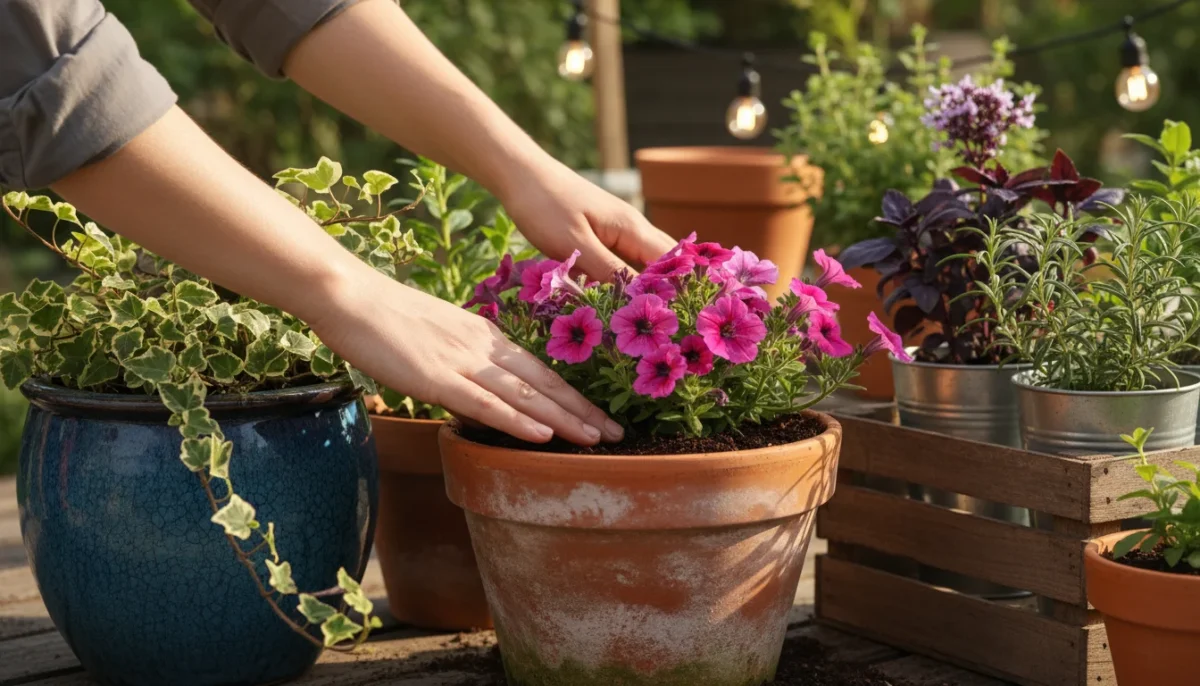Your small space offers incredible potential for vibrant, ever-changing garden displays. Seasonal container gardening transforms your balcony, patio, or compact yard into a dynamic canvas, bringing beauty and life throughout the year. Imagine fresh spring blooms, lush summer foliage, warm autumn tones, and serene winter evergreens, all tailored to your unique outdoor area. We guide you through creating stunning, low-maintenance, and environmentally conscious year-round displays. Embrace the opportunity to express your personal style and enjoy a thriving garden, no matter the size of your space. Cultivating beautiful garden color ideas becomes effortless when you plan for continuous interest. This article helps you master the art of year-round displays with practical tips and plant suggestions.
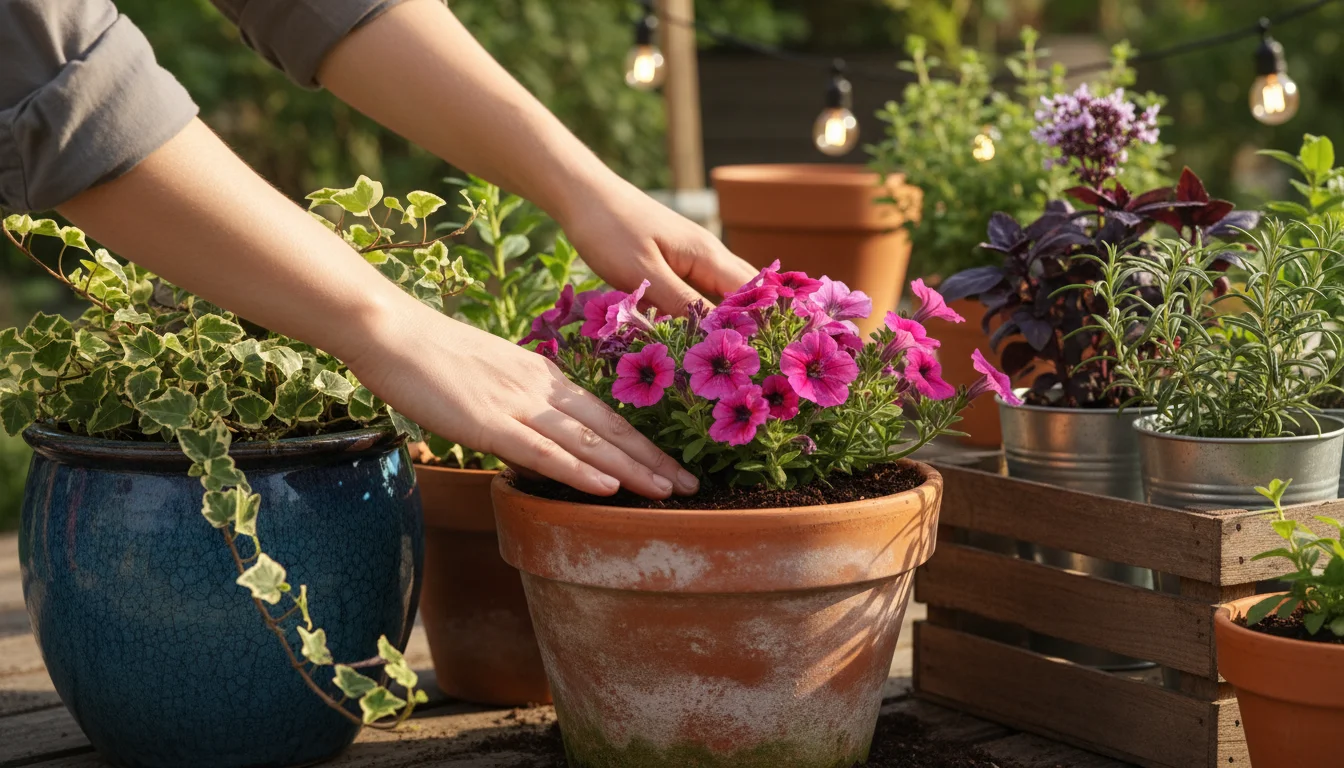
Why Seasonal Container Gardening Matters
Container gardening provides unparalleled flexibility for small spaces. You control the soil, light exposure, and placement of each plant, allowing you to optimize conditions for success. Seasonal container gardening extends this control, enabling you to refresh your outdoor aesthetic as the year progresses. This approach offers significant advantages:
- Continuous Interest: You avoid the common problem of a garden looking spectacular for a few weeks, then fading. By planning for each season, you ensure your space always offers something visually engaging. You create dynamic garden color ideas that shift with the calendar.
- Optimized Plant Health: You select plants suited to the current weather, reducing stress and disease. This means healthier, more vigorous plants that perform better.
- Pest and Disease Management: Rotating plants and refreshing soil minimizes the buildup of pests and diseases specific to certain species. You effectively reset your growing conditions each season.
- Creative Expression: Containers are like movable art installations. You experiment with new plant combinations, textures, and colors every few months, keeping your space exciting and personal. This makes achieving stunning year-round displays an enjoyable creative process.
- Space Efficiency: You maximize every square inch. Vertical gardening structures, tiered planters, and hanging baskets extend your planting area upwards, making small spaces feel larger and more abundant.
- Accessibility: Elevated containers reduce bending and kneeling, making gardening more accessible for everyone. You manage your garden from a comfortable standing or seated position.
Embracing seasonal container gardening means you consistently enhance your outdoor living area. You transform a compact space into a vibrant, evolving sanctuary, showcasing beautiful garden color ideas all year long.
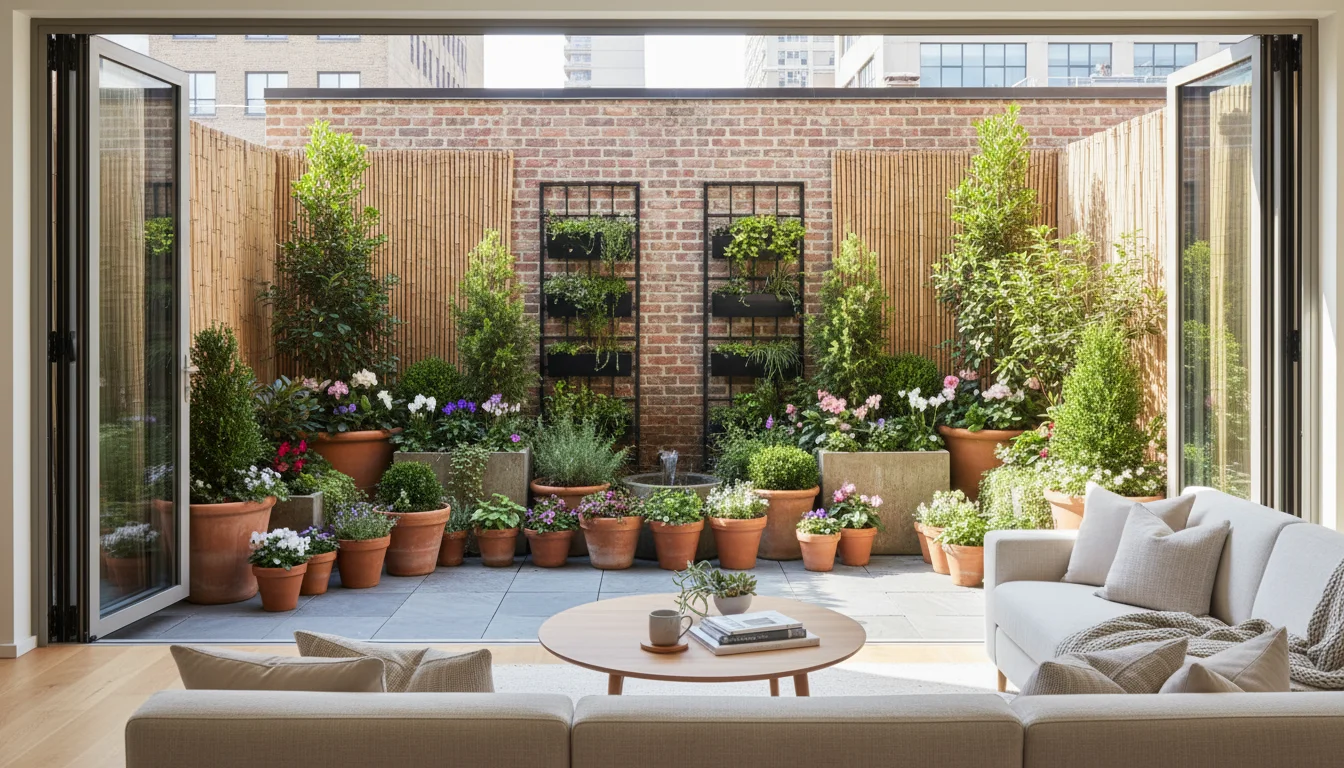
Designing Your Year-Round Container Garden
Effective design elevates your seasonal container displays from a collection of pots to a cohesive garden statement. Start with a clear vision, considering your space’s layout and how you use it. Think about the view from indoors, the path you walk, and where you like to sit. Your goal is to create year-round displays that delight the eye and feel integrated.
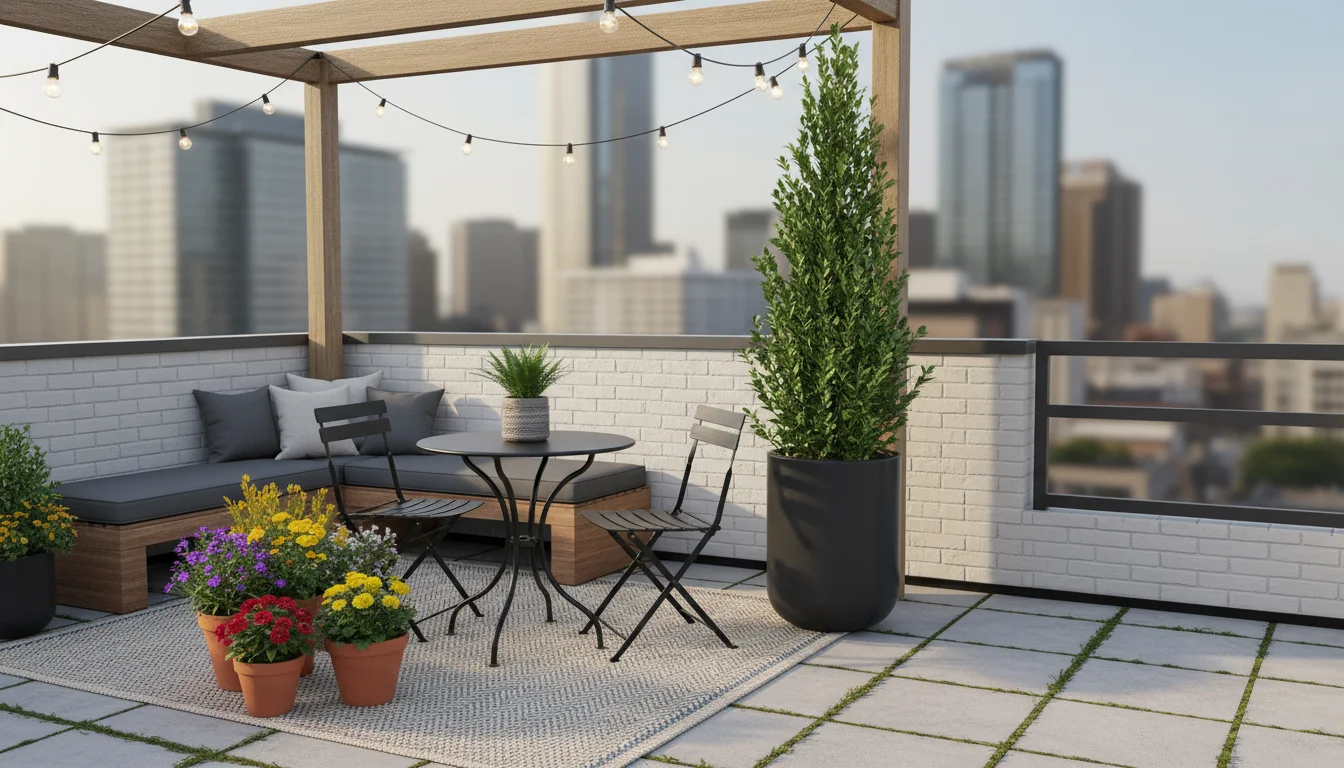
Defining Your Layout and Focal Points
Begin by sketching your space. Identify zones for dining, relaxation, or high traffic. Allocate container groupings to these zones. A focal point is the first thing your eye notices. This might be a particularly striking plant, a unique container, or a cluster of varied pots. Place focal points strategically to draw attention to desirable areas. For instance, a tall, sculptural evergreen in an elegant container makes a strong statement near an entry or at the end of a sightline from a window. Consider how containers define pathways or delineate “rooms” within your small outdoor area.
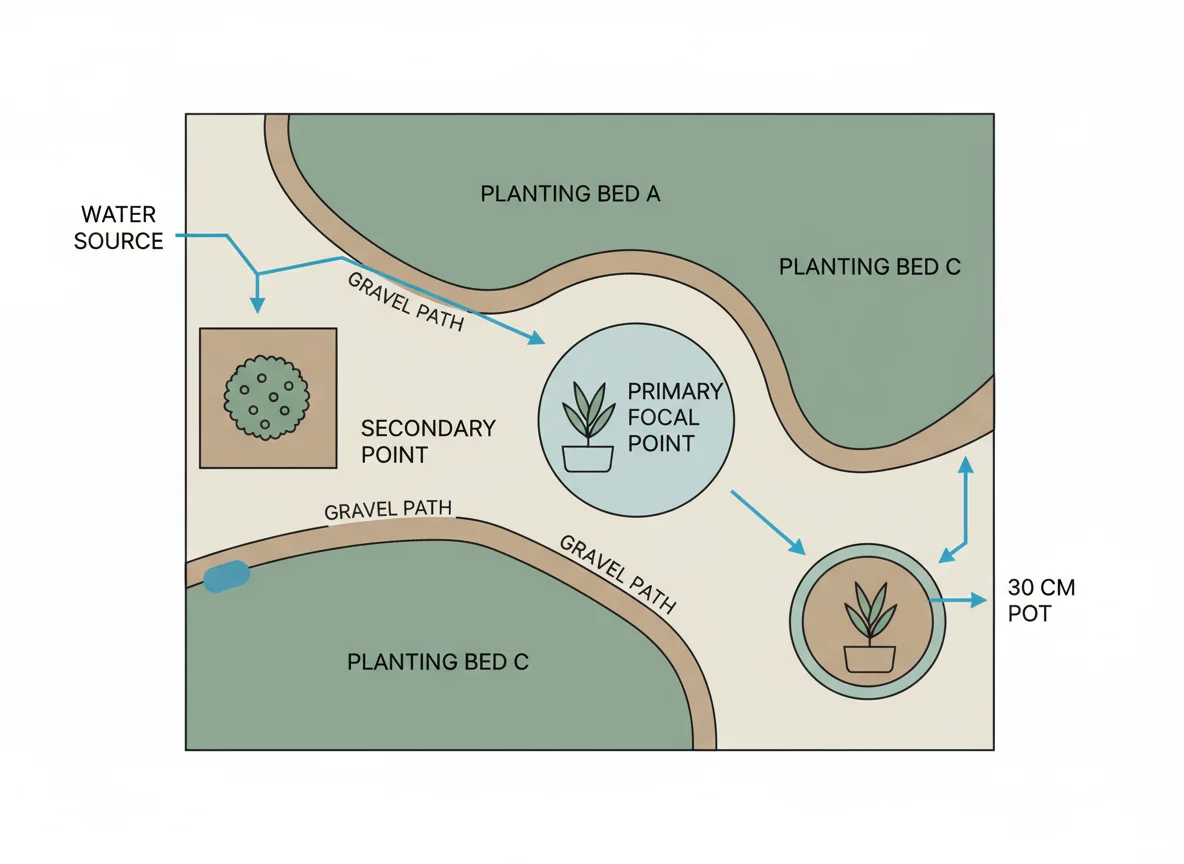
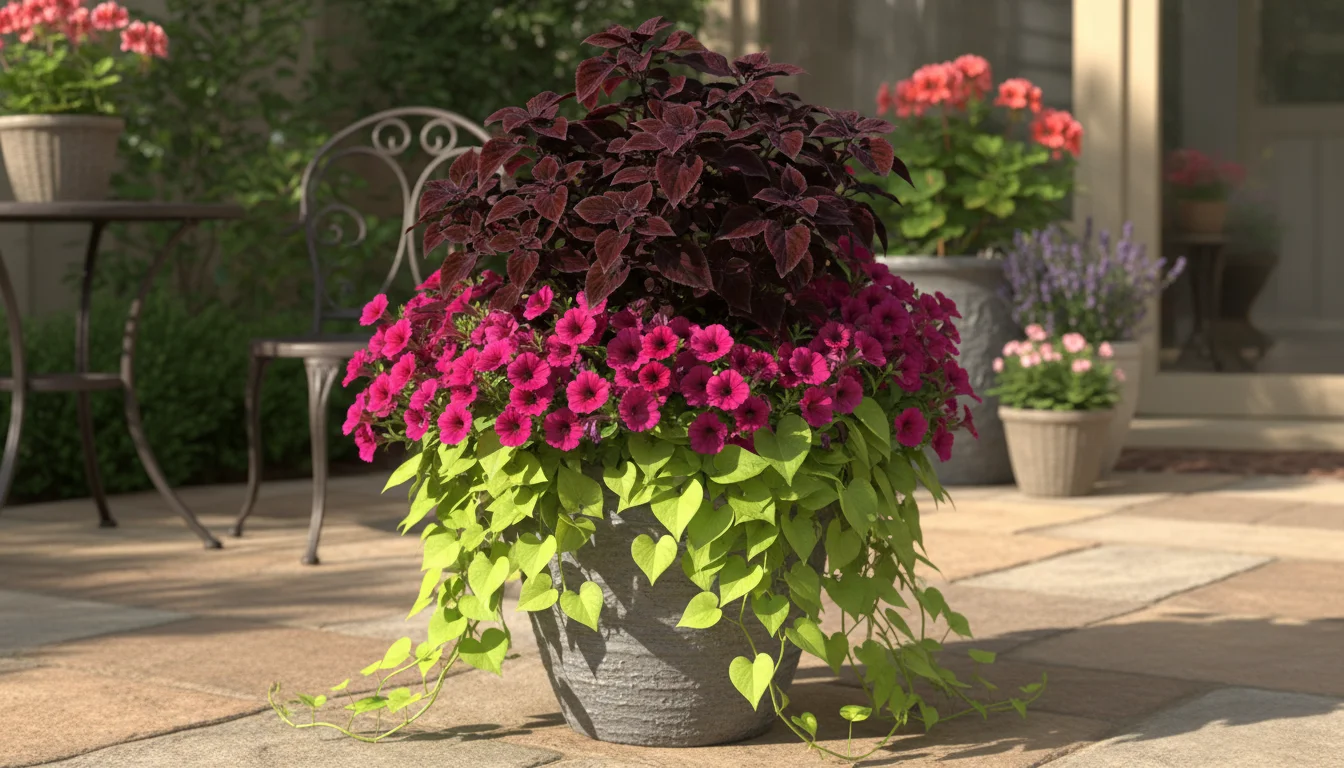
The Thriller, Filler, Spiller Concept
This classic container design formula creates balanced, attractive arrangements:
- Thriller: A tall, dramatic plant that provides vertical interest and acts as the focal point of the individual container. It commands attention. Examples include ornamental grasses, canna lilies, or a small evergreen shrub.
- Filler: Medium-sized plants that fill the space around the thriller, adding mass, texture, and color. They provide a lush, full appearance. Think petunias, coleus, or impatiens.
- Spiller: Plants that cascade over the edge of the container, softening its lines and adding a graceful element. They connect the pot to its surroundings. Examples include creeping Jenny, sweet potato vine, or lobelia.
Apply this formula to individual pots and also to groupings of containers. You might have a large pot with a thriller, a few medium pots with fillers, and smaller pots with spillers, all arranged to form a cohesive vignette. This helps you achieve diverse garden color ideas and dynamic compositions.
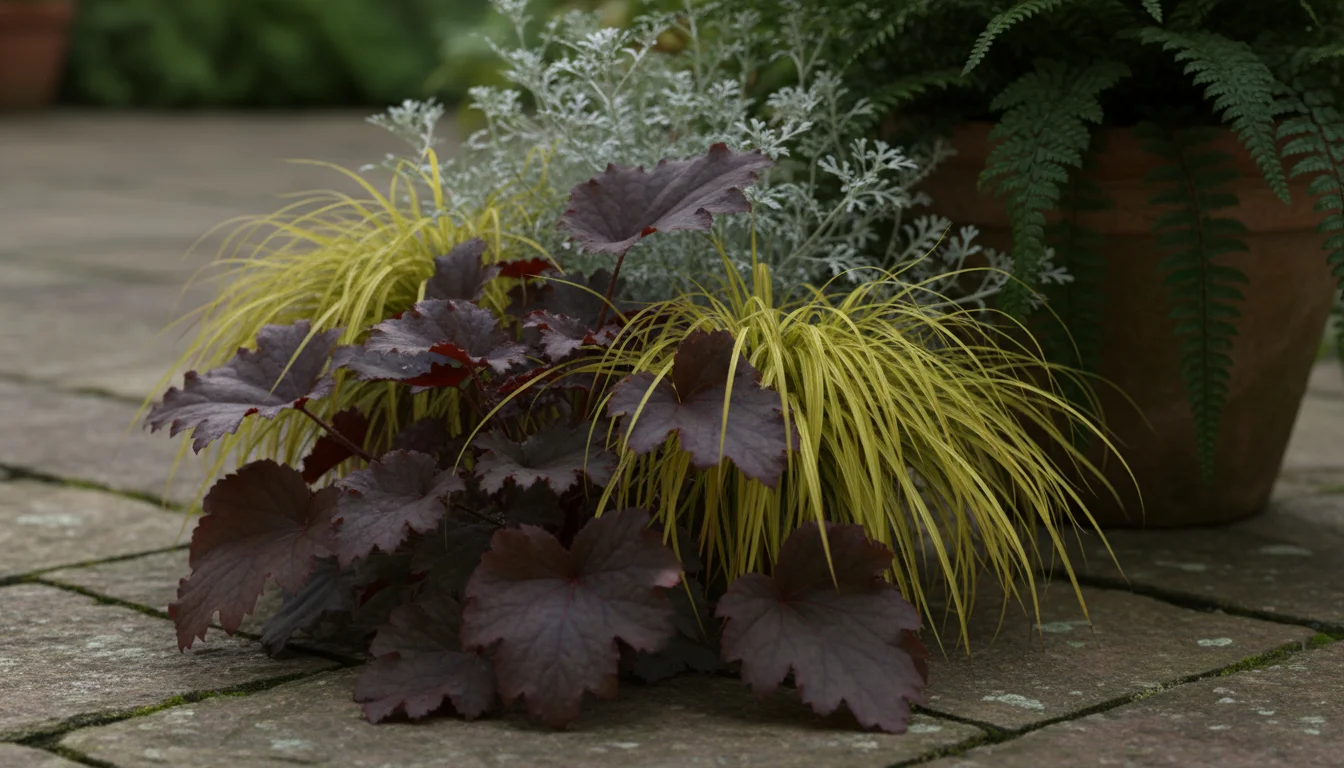
Color and Texture Palettes
Thoughtful color and texture choices unify your seasonal container gardening efforts. Select a primary color palette for each season, considering how these colors interact and how they complement your home’s exterior.
Use contrasting textures, such as broad leaves next to feathery foliage, to add depth and interest. Remember foliage plants offer color and texture throughout the growing season, often outlasting blooms. Silver, chartreuse, and deep burgundy leaves provide year-round interest and serve as excellent backdrops for seasonal flowers. Data suggests that foliage plants account for a significant portion of visual interest in well-designed gardens, often providing more consistent appeal than fleeting blooms. For example, a container with purple fountain grass (thriller), ‘Wasabi’ coleus (filler), and ‘Sweet Caroline’ sweet potato vine (spiller) creates a striking summer display with rich color and varied textures. These choices deliver excellent garden color ideas beyond just flowers.
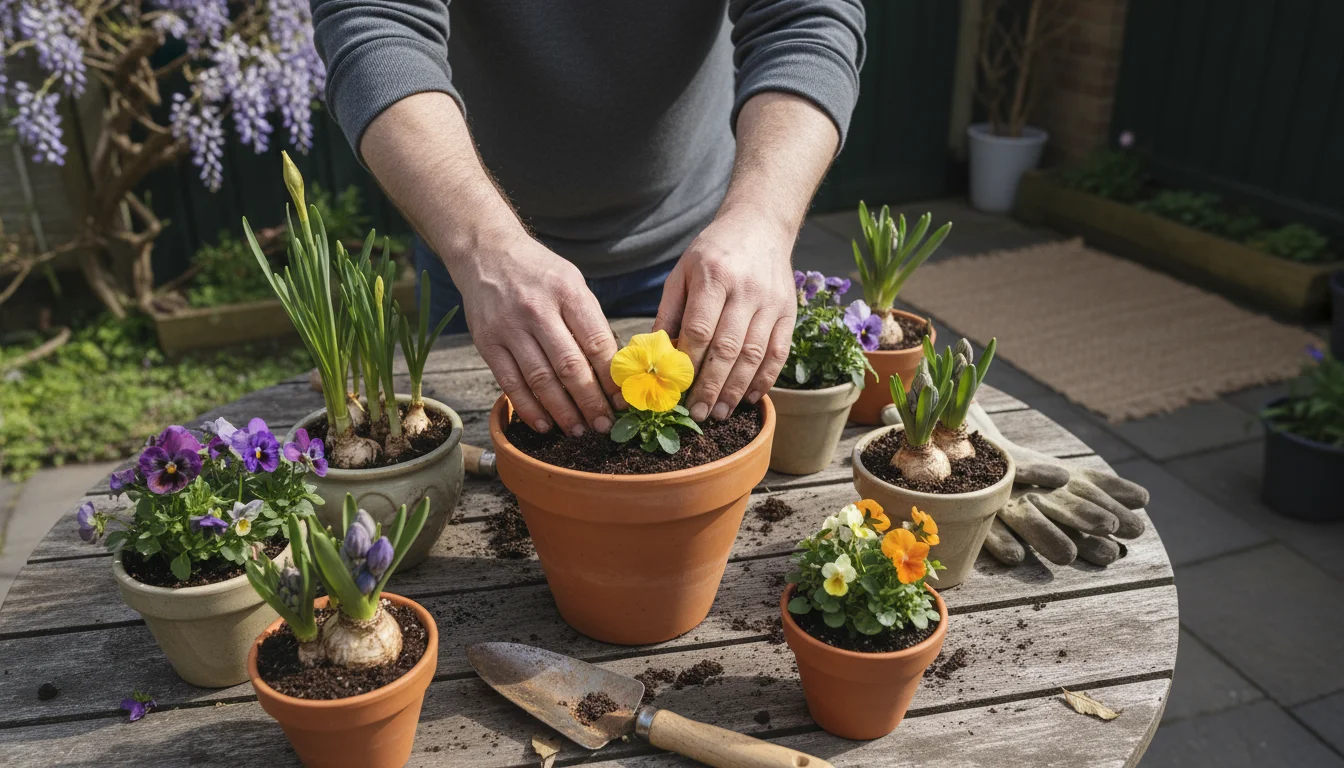
Spring Container Displays: Fresh Starts
Spring container gardening signals renewal, bursting with fresh growth and cheerful blooms. As temperatures rise, transition your containers to reflect this awakening. Plan for early spring, when frosts might still occur, and mid-to-late spring, when more tender plants emerge.
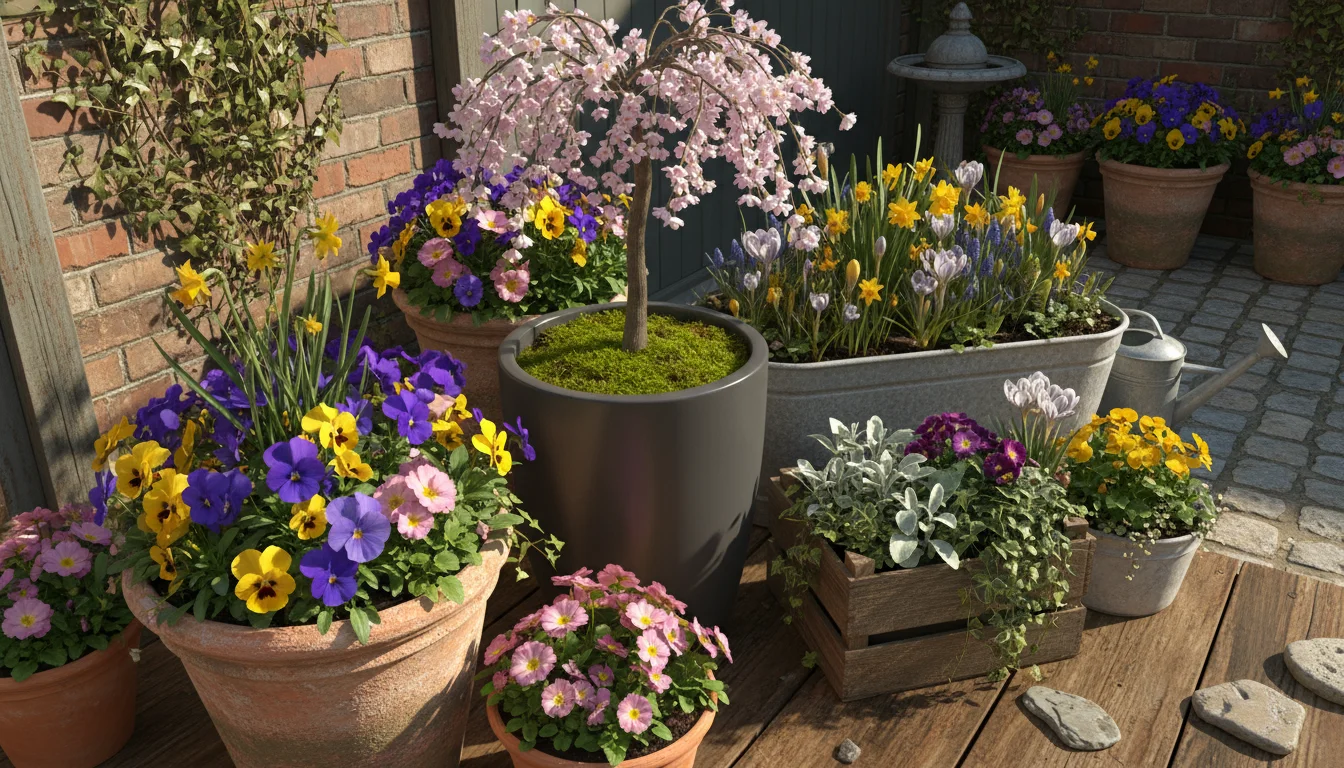
Early Spring Choices
Focus on hardy plants that tolerate cooler temperatures and even a late frost. Pansies, violas, and primroses are perfect early spring additions, offering a wide array of garden color ideas. Their vibrant faces instantly lift the mood. Combine them with small, resilient evergreens such as dwarf conifers or heuchera, also known as coral bells, which provide continuous texture and subtle color. Heuchera varieties offer foliage in shades of purple, lime green, and bronze, giving you structure that lasts beyond spring. Add texture with ornamental cabbage or kale for robust, cold-tolerant interest. Consider placing spring-flowering bulbs, like tulips or daffodils, directly into containers for a dramatic pop of color, then transplant them to the ground or a less visible spot once they fade.
- Thrillers: Dwarf conifer, small ornamental grass like ‘Elijah Blue’ fescue, or a compact pussy willow.
- Fillers: Pansies, violas, primroses, heuchera, cyclamen.
- Spillers: Creeping Jenny (Lysimachia nummularia), ivy (Hedera helix), or Ajuga reptans.
Ensure containers have excellent drainage to prevent root rot during wet spring conditions. Use a high-quality, peat-free potting mix. For ongoing vibrancy, deadhead spent blooms regularly. This encourages new flower production and keeps your container displays looking tidy and productive.
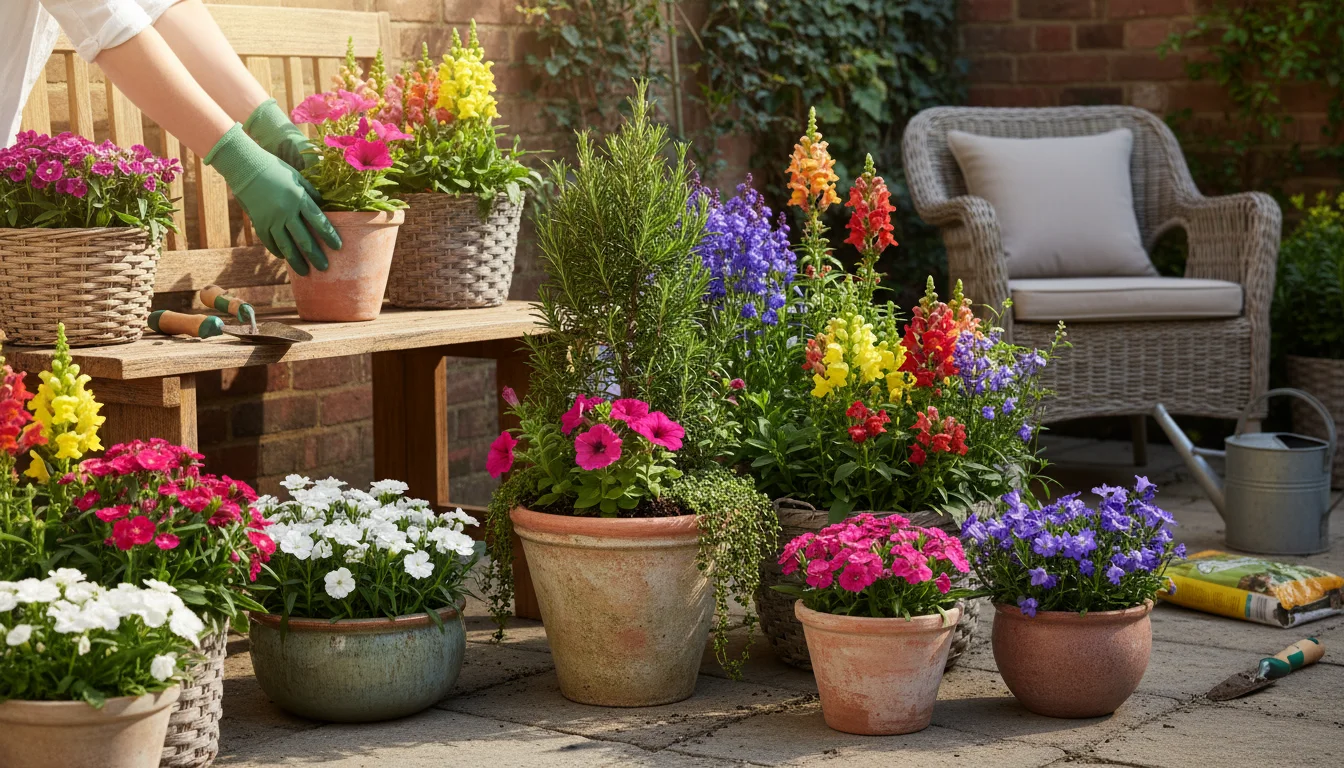
Mid to Late Spring Expansion
As the risk of frost diminishes, you introduce a broader range of plants. Consider early perennials that bloom in spring, such as dianthus, bellflowers, or bleeding hearts, which can be moved into the ground later. Introduce annuals that thrive in warming temperatures, like petunias, calibrachoa, and snapdragons, for extended bloom time. Incorporate herbs such as rosemary, thyme, and chives for both their culinary value and their attractive foliage and flowers. Rosemary, with its upright growth, can serve as a thriller, while thyme cascades beautifully as a spiller. These additions contribute diverse textures and garden color ideas to your year-round displays.
Ensure adequate watering as temperatures increase. A moisture meter can help you determine when your plants truly need water, preventing both over and under watering. You conserve water resources and keep your plants healthy. Look for slow-release fertilizers designed for containers to provide steady nutrients throughout the season.
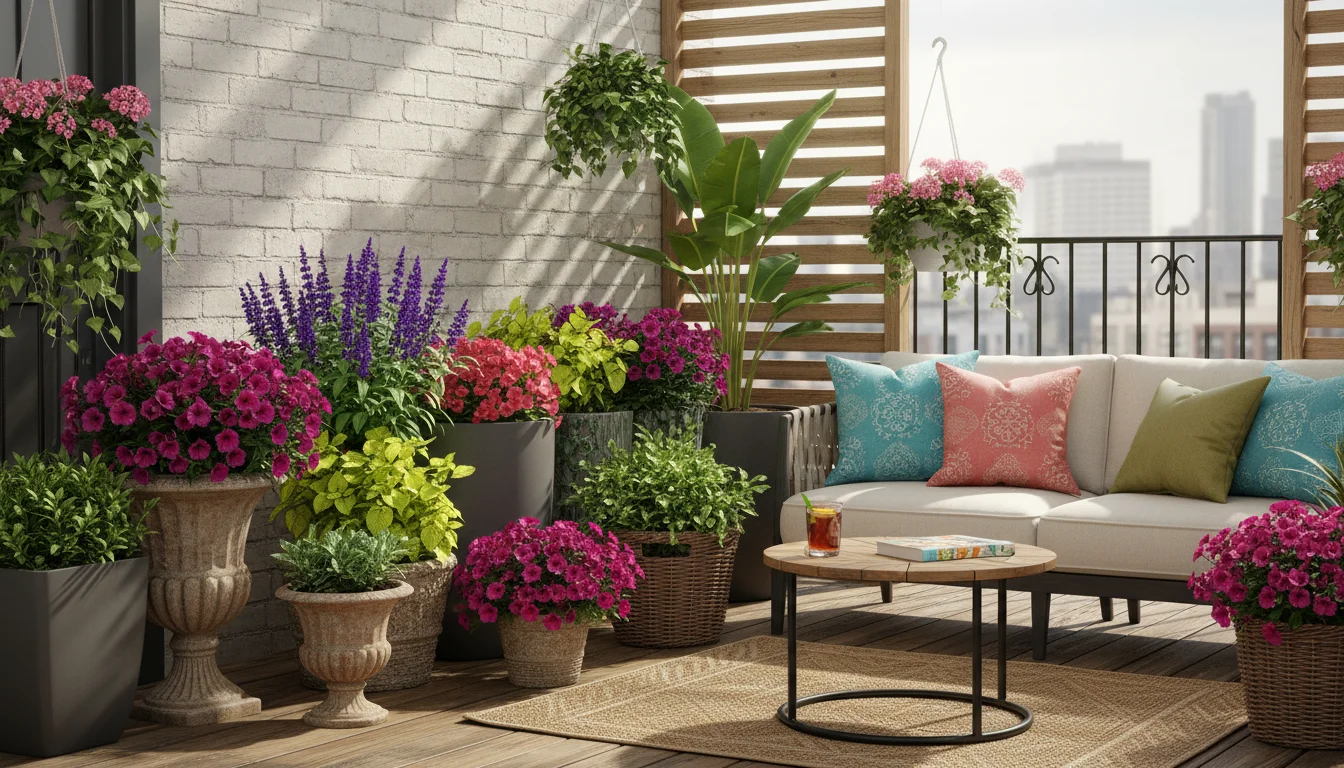
Summer Container Displays: Vibrant Abundance
Summer offers the most extensive palette for seasonal container gardening. Your goal is to create lush, colorful year-round displays that withstand the heat and humidity of the season. Maximize impact with bold plant choices and smart watering strategies.
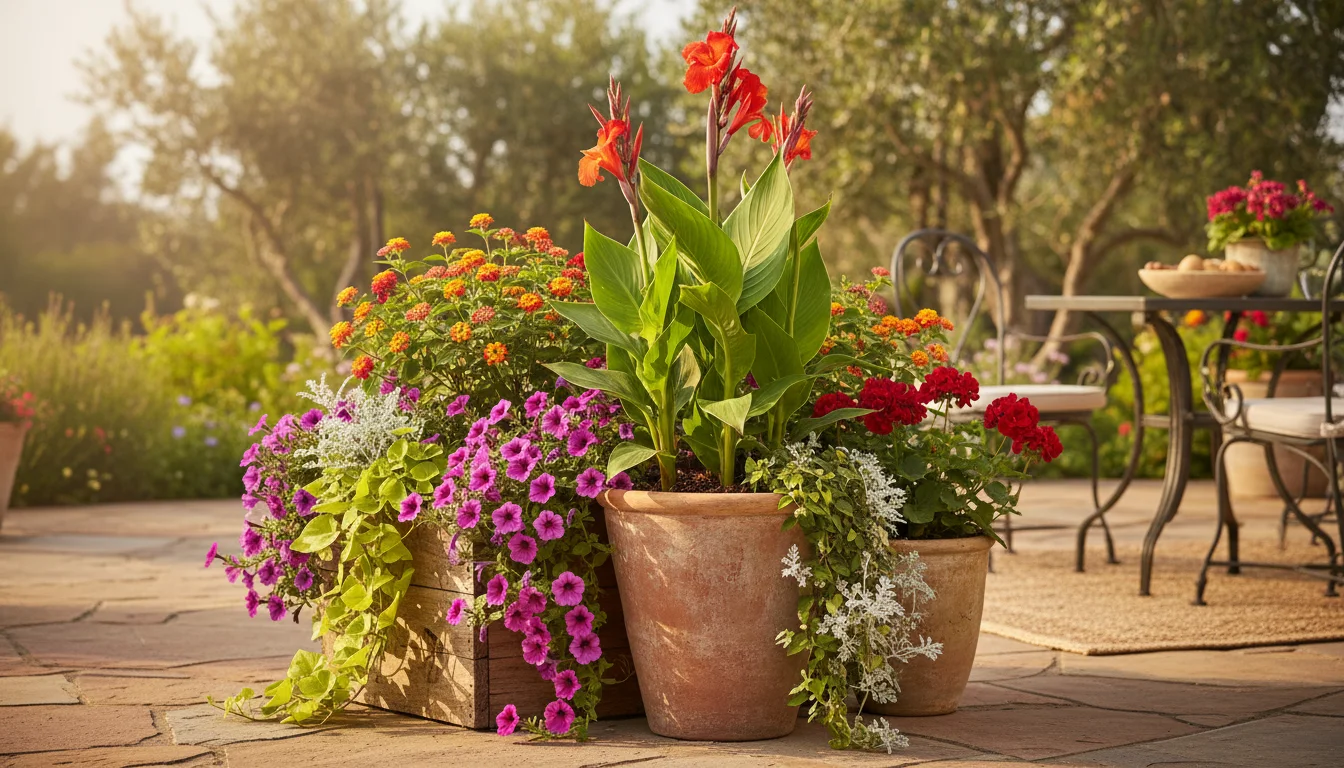
Sun-Loving Spectaculars
For sunny balconies and patios, choose heat-tolerant plants known for their vigorous growth and prolific blooms. Petunias, calibrachoa, verbena, and zinnias are all excellent choices for continuous color. Combine them with foliage plants like coleus, sweet potato vine, or dusty miller, which offer contrasting textures and shades. Coleus, in particular, comes in an astonishing array of colors, from vibrant lime green to deep burgundy, providing fantastic garden color ideas even without flowers. Ornamental grasses such as purple fountain grass add vertical elegance and movement. Consider a dwarf citrus tree or a small olive tree in a large container for a Mediterranean flair, providing both structure and potential edible yields.
- Thrillers: Canna lily, purple fountain grass, dwarf banana plant, Mandevilla on a small trellis.
- Fillers: Petunias, calibrachoa, verbena, impatiens (shade), coleus, begonia.
- Spillers: Sweet potato vine, bacopa, dichondra ‘Silver Falls’, nasturtium.
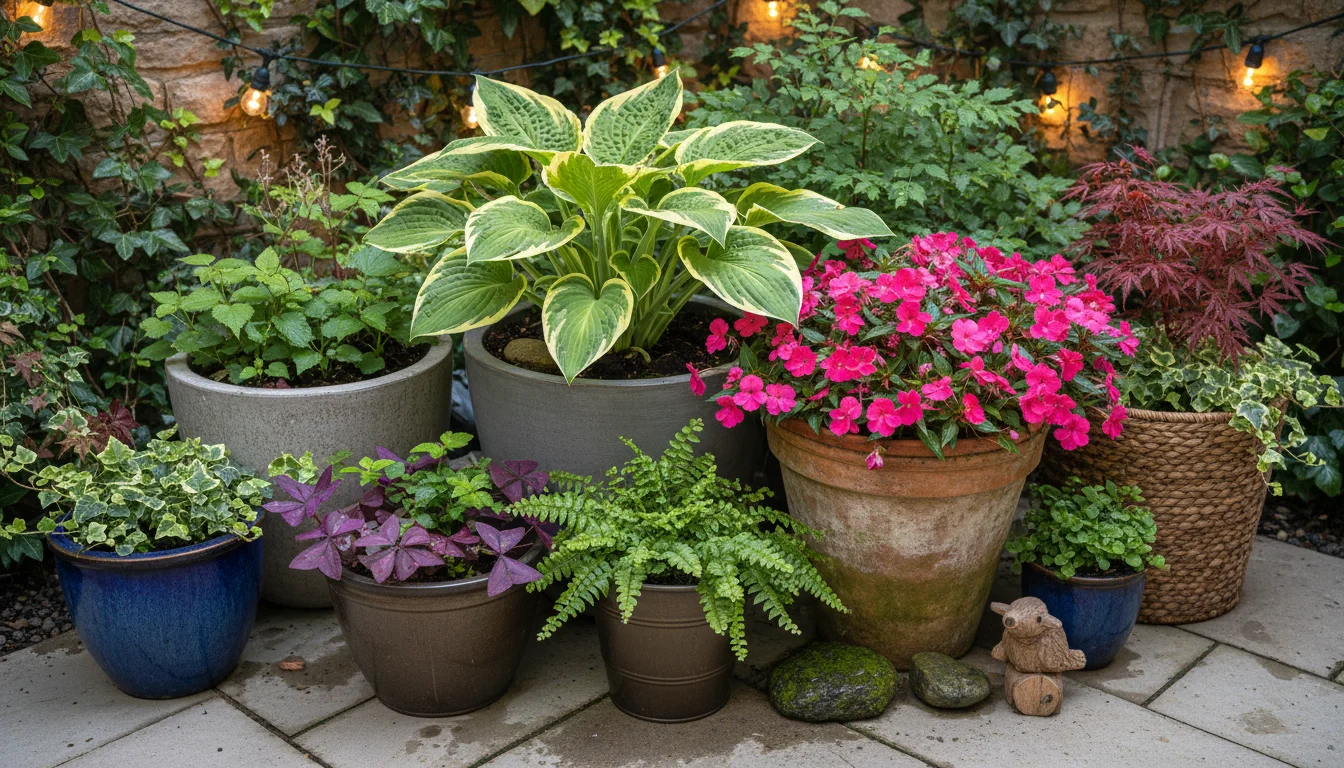
Shade-Tolerant Beauties
Even shady spots can host stunning summer containers. Impatiens, tuberous begonias, fuchsias, and coleus thrive in indirect light, bringing vibrant color to darker corners. Ferns, hostas, and ivy provide rich green textures and architectural form. Combine variegated hostas with bright impatiens for a dynamic display that brightens a shaded area. Hydrangeas in containers offer large, showy blooms for partial shade. Their substantial presence makes them excellent thrillers, and many dwarf varieties suit container life.
Watering is crucial in summer. Container plants dry out faster than those in the ground. Check soil moisture daily, especially during heatwaves. Use saucers or drip trays under pots to catch excess water and prevent runoff, but do not let plants sit in standing water for extended periods. Consider a slow-drip irrigation system for multiple containers. This saves you time and ensures consistent moisture, which is vital for maintaining vibrant seasonal container gardening. According to the USDA Agricultural Marketing Service, efficient watering practices significantly reduce water waste in gardening. Fertilize regularly with a balanced liquid fertilizer every two to four weeks, or use a slow-release granular product at the beginning of the season to support continuous growth and bloom.
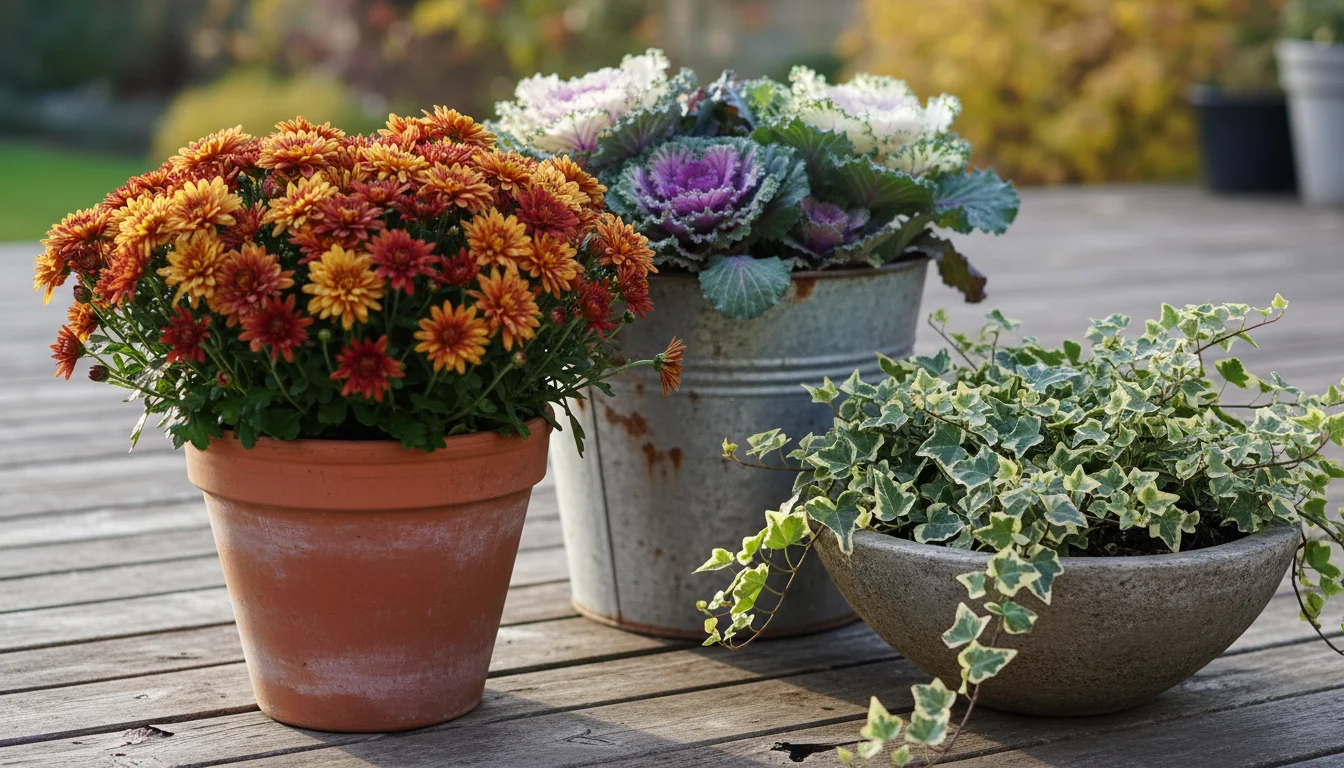
Fall Container Displays: Harvest Hues
Autumn brings a magnificent shift in color, offering rich, warm tones for your seasonal container gardening. Transitioning your year-round displays for fall means embracing cool-season plants, vibrant foliage, and rustic textures. This season celebrates the harvest and prepares for the quieter months ahead.
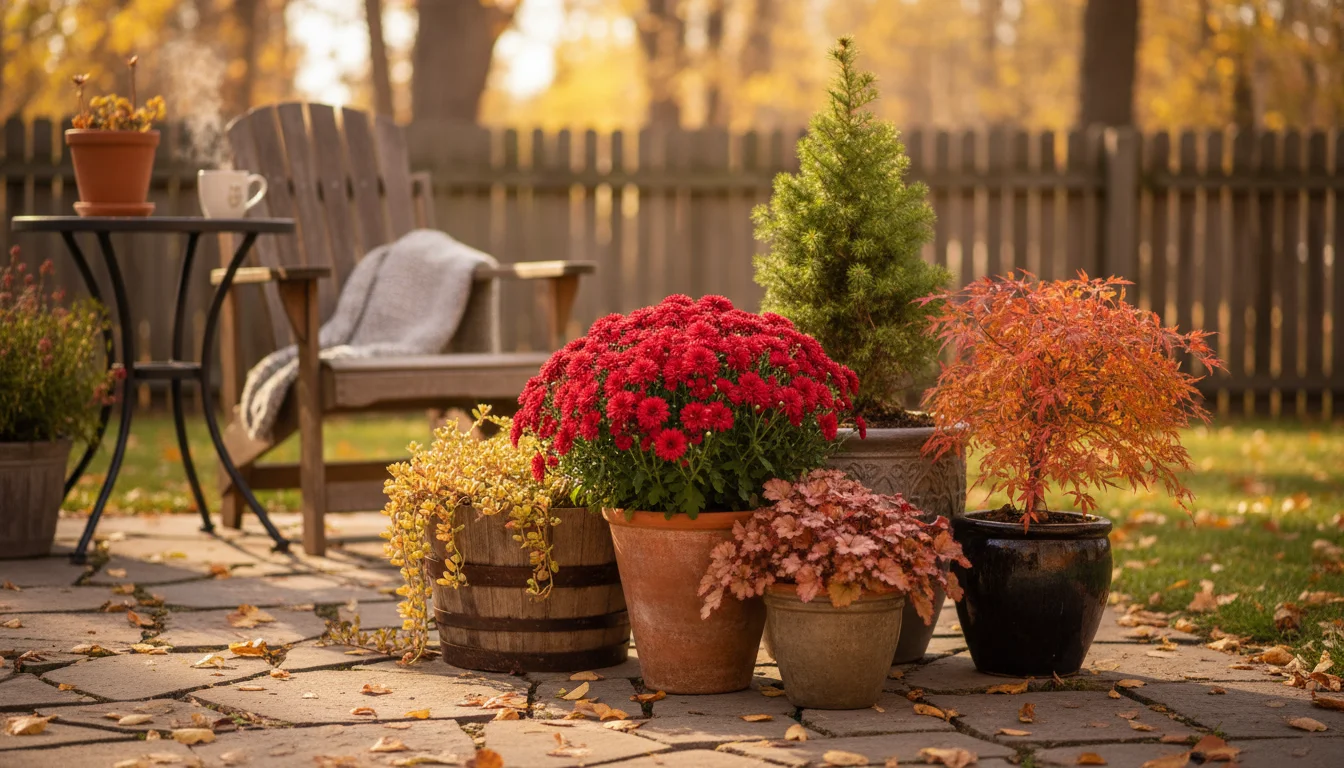
Embracing Autumnal Colors
Mums are the undisputed stars of fall containers, providing an instant burst of color in shades of red, orange, yellow, and purple. Pair them with ornamental kale and cabbage, which deepen in color as temperatures drop, offering striking foliage and texture. Pansies and violas, often available as transplants in fall, offer a cheerful reprise and can even survive mild winters to rebloom in spring. Heuchera varieties, with their evergreen foliage in deep bronzes and burgundies, provide consistent garden color ideas. Consider adding small conifers, such as dwarf Alberta spruce, or evergreens like boxwood, which provide structure and remain attractive through winter. These make excellent thrillers for fall displays.
- Thrillers: Ornamental grasses (e.g., fountain grass, switchgrass), small conifer, kale or cabbage (tall varieties), compact evergreen shrub.
- Fillers: Mums, pansies, violas, heuchera, gaultheria (wintergreen), ornamental peppers.
- Spillers: Trailing ivy, creeping Jenny (foliage color changes), Ajuga, sedum ‘Autumn Joy’.
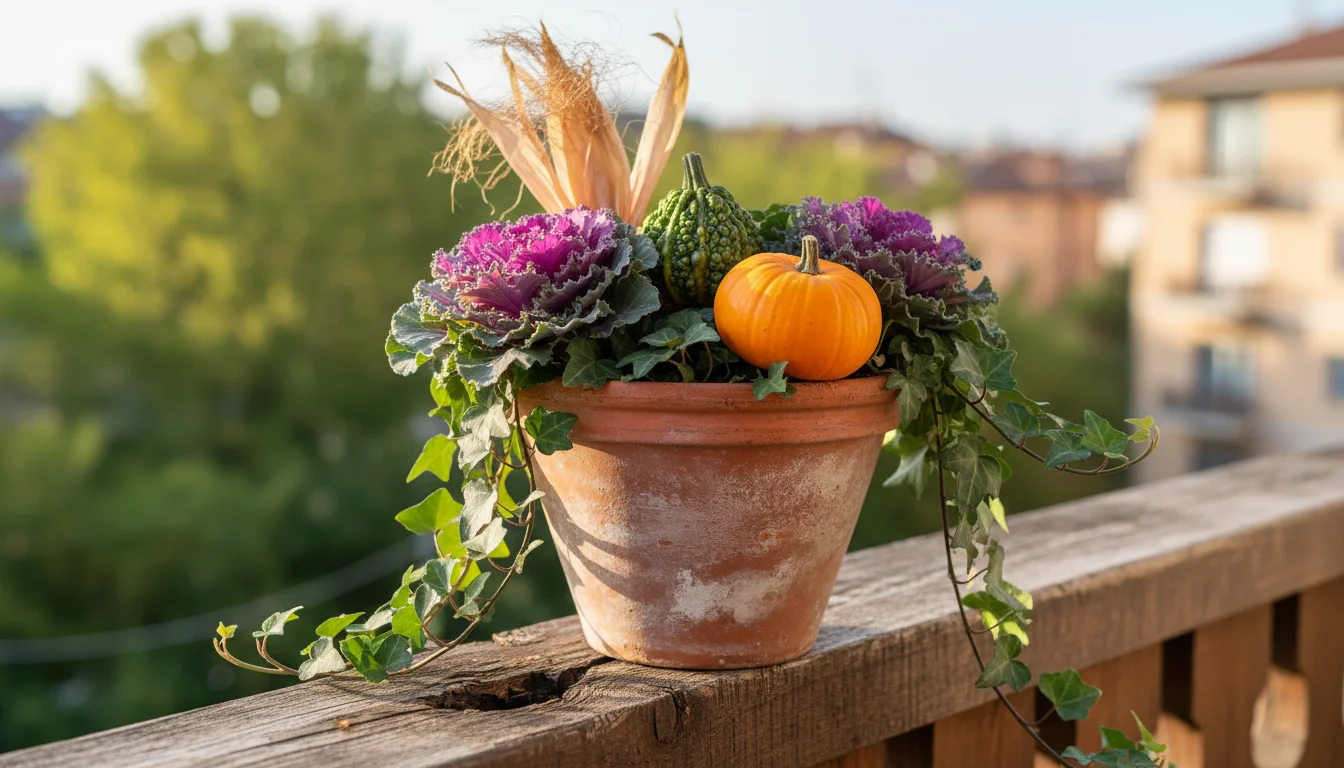
Adding Texture and Natural Elements
Beyond plants, incorporate natural elements to enhance the fall theme. Small gourds, mini pumpkins, dried corn stalks, or bundles of raffia add a rustic, harvest feel. Position these elements among your plants for a visually rich display. For additional height and drama, consider inserting branches with colorful fall leaves or vibrant berries. These non-plant elements create unique garden color ideas and seasonal accents. As temperatures cool, reduce watering frequency. Allow the top inch or two of soil to dry out between waterings. Protect tender fall plants from early frosts by covering them overnight or moving them indoors if possible. Some hardier plants, such as pansies and kale, tolerate light frost well and can continue to perform through late fall.
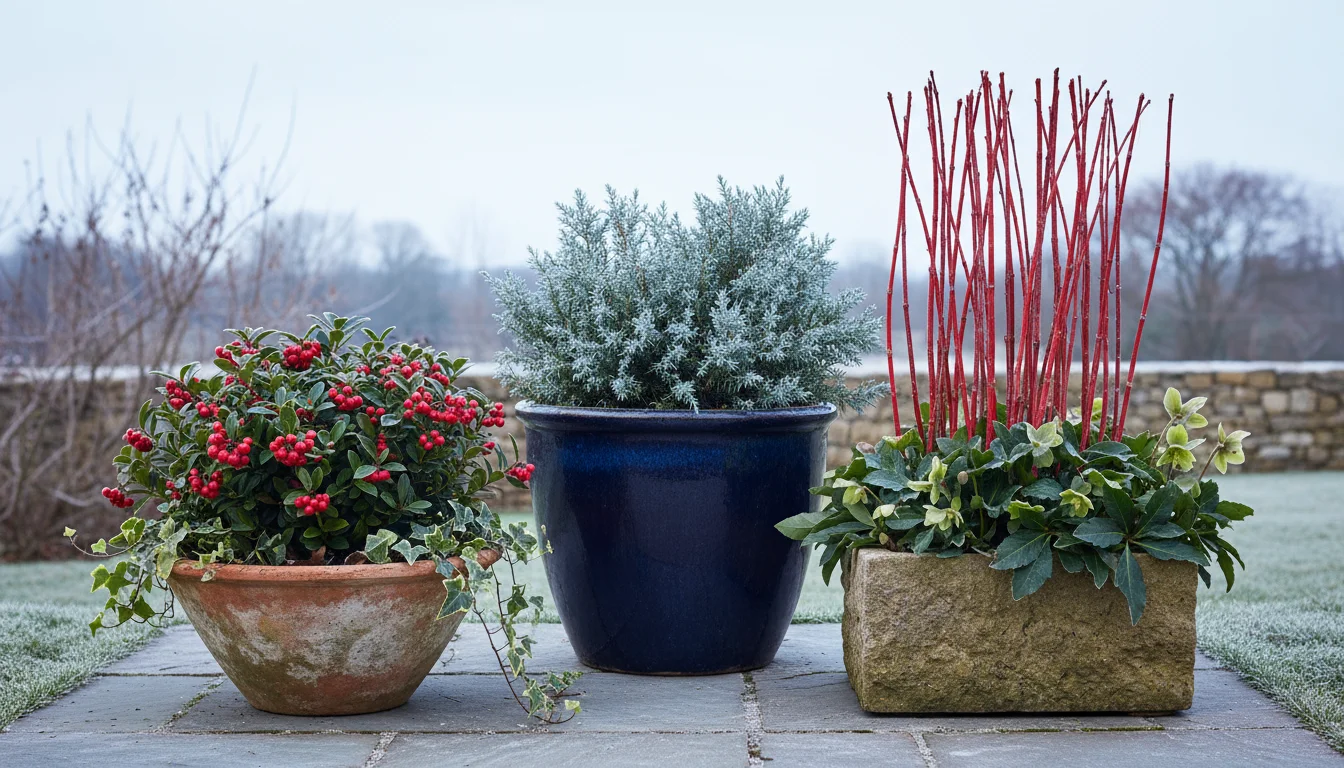
Winter Container Displays: Evergreen Elegance
Winter container gardening focuses on structure, texture, and subtle beauty. While blooms are scarce, your year-round displays can still offer significant visual appeal, providing much-needed greenery and a sense of life during the colder months. Think beyond flowers and emphasize evergreens, interesting branches, and subtle touches of color.
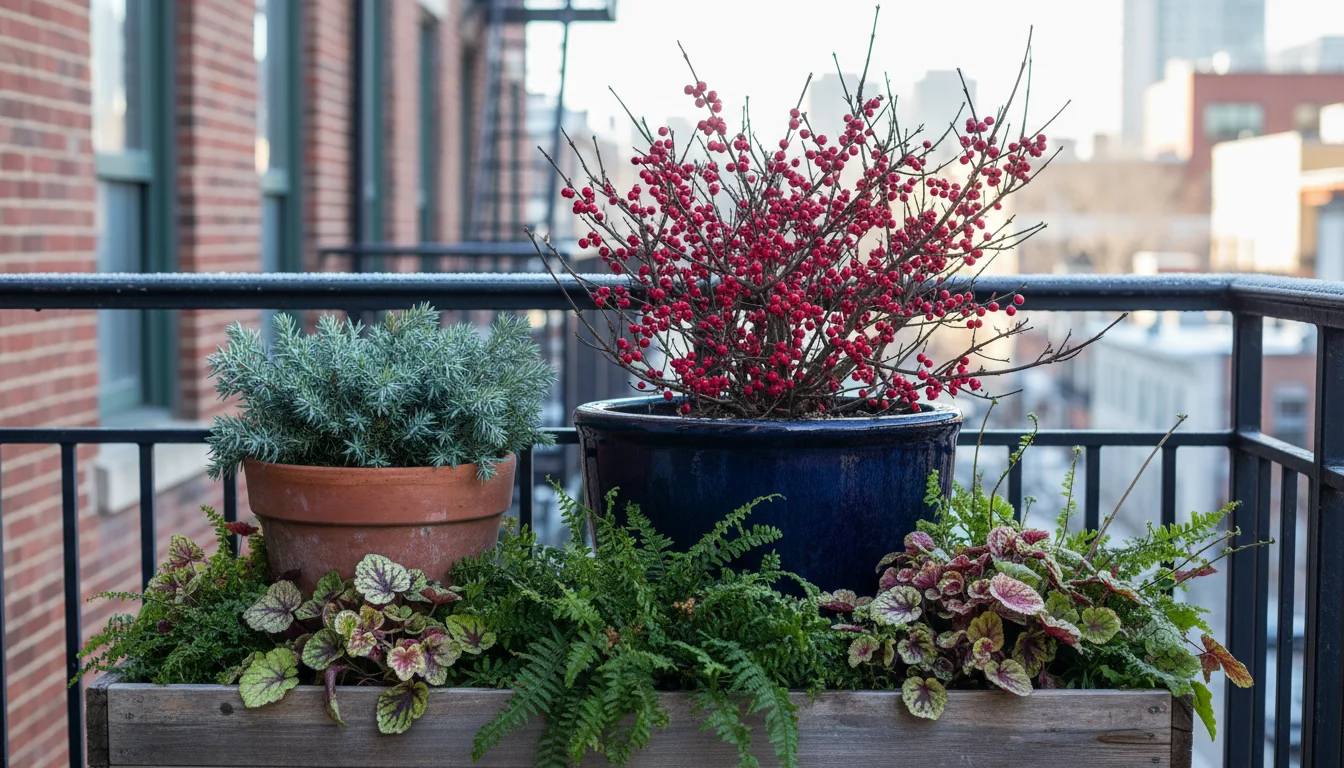
Building with Evergreens
Dwarf conifers are your best friends for winter containers. Varieties like dwarf Alberta spruce, juniper, or mugo pine provide evergreen structure and texture. Mix different shades of green, blue, and gold foliage for contrast. Boxwood, holly (with its bright berries), and various euonymus offer reliable evergreen options. Winter-blooming heathers provide delicate flowers and interesting foliage. For something unique, try a winterberry holly, whose bare branches become adorned with bright red berries after its leaves drop, offering striking garden color ideas.
- Thrillers: Dwarf conifer (e.g., ‘Blue Star’ juniper, dwarf Alberta spruce), slender holly, boxwood pyramid, winterberry holly.
- Fillers: Heuchera, hellebores (Christmas rose), evergreen ferns, dwarf mondo grass, sedum ‘Angelina’.
- Spillers: Trailing ivy, creeping juniper, ‘Wintercreeper’ euonymus.
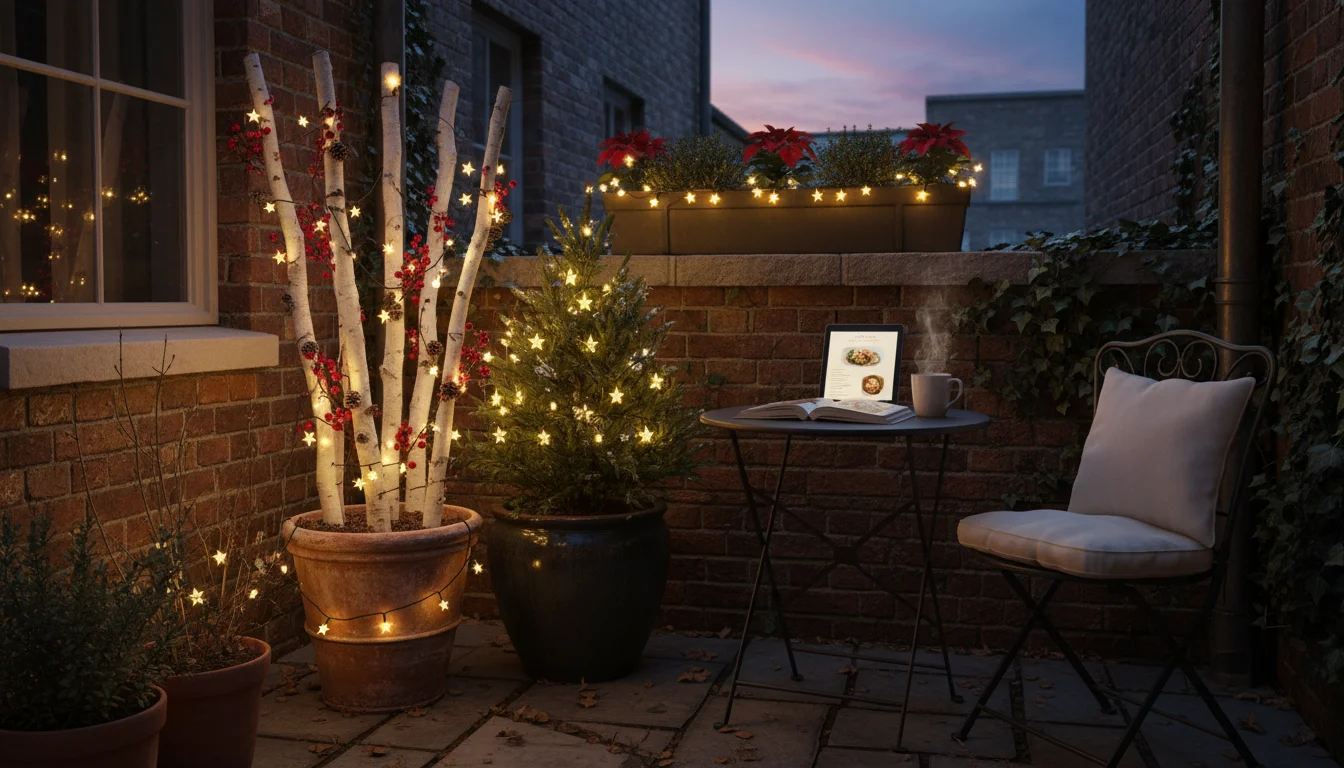
Adding Seasonal Accents
Beyond live plants, incorporate decorative elements that withstand cold weather. Birch branches, pinecones, seed pods, and festive ornaments can be artfully arranged. Battery-operated string lights or solar-powered lanterns add a warm glow, enhancing the ambiance during long winter nights. Consider a splash of color with artificial red berries or weather-resistant ribbons. These elements provide visual interest when the garden is dormant, maintaining your year-round displays.
Even in winter, containers require some water. Check the soil moisture periodically, especially during dry spells or mild periods. Frozen soil means plants cannot absorb water, so water when temperatures are above freezing. Avoid overwatering, which can lead to root rot. Protecting containers from extreme cold is vital. Move smaller pots to a sheltered location, like against a warm wall or near an entryway. For larger, immovable containers, wrap them with burlap or bubble wrap to insulate the roots. This prevents freeze-thaw cycles from damaging the roots and keeps your evergreen plants healthy for their vital role in seasonal container gardening. For more information on winter container care, consult resources like the Royal Horticultural Society, which offers detailed guides on protecting plants in cold weather.
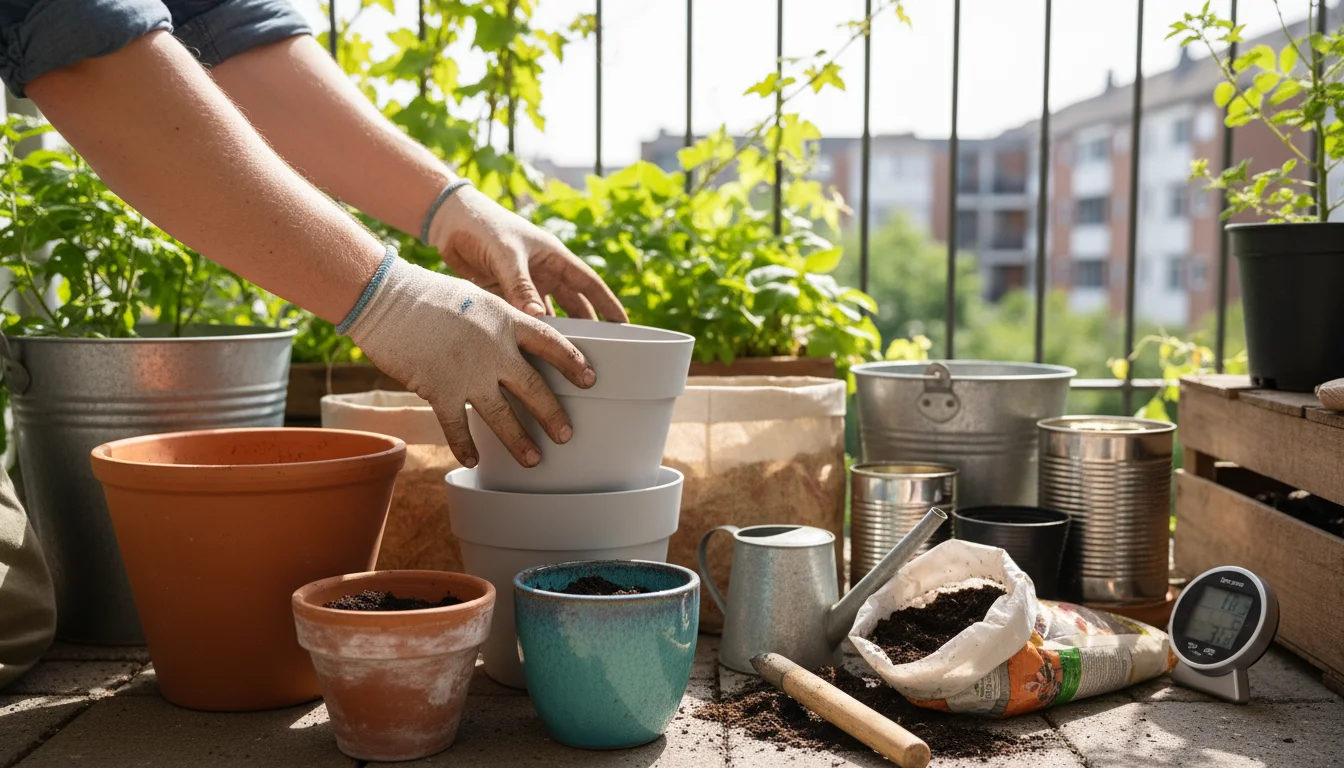
Container Strategy and Materials
Choosing the right containers is as important as selecting the right plants. Your container strategy impacts plant health, maintenance, and the overall aesthetic of your year-round displays. Consider size, material, and mobility.
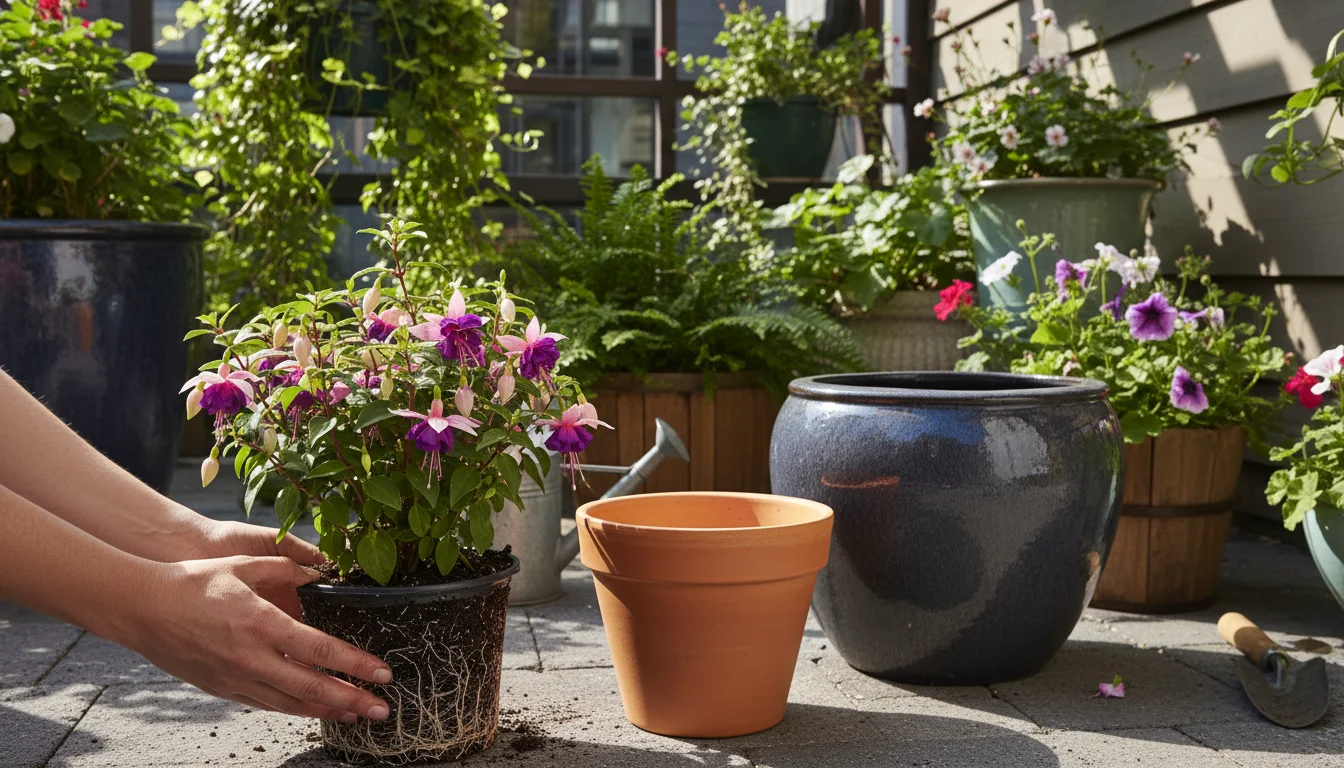
Size Matters
Larger containers generally provide more stable growing conditions. They hold more soil, which retains moisture longer and insulates roots from temperature fluctuations. While small pots might seem ideal for a compact space, they dry out quickly and require frequent watering. Aim for containers that are at least 12-15 inches in diameter for most seasonal plantings. If you must use smaller pots, group them closely together to create a microclimate that reduces moisture loss.
For thrillers or plants intended to last multiple seasons, select containers 18-24 inches or larger. The rule of thumb: the root ball should have at least 2-3 inches of space all around it for growth. This ensures your plants have ample room to develop strong root systems, supporting healthy, vigorous year-round displays.
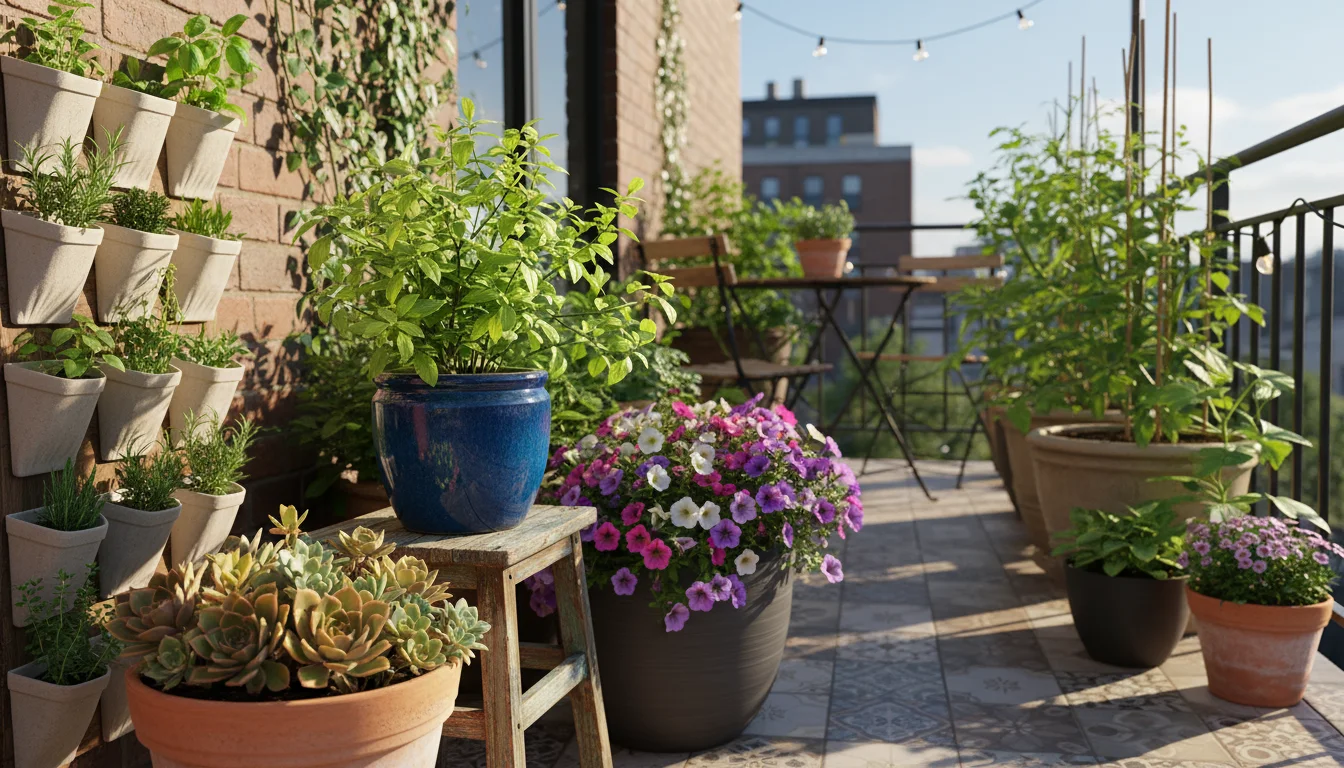
Container Materials and Their Benefits
The material of your container affects its weight, durability, and how quickly the soil dries. Choose materials that complement your aesthetic and practical needs:
| Material | Pros | Cons | Best Use |
|---|---|---|---|
| Terracotta/Clay | Porous, promotes air circulation to roots, classic look. | Dries out quickly, heavy, prone to cracking in freezing temperatures, can accumulate mineral salts. | Drought-tolerant plants, rustic aesthetics, warm climates. |
| Plastic/Resin | Lightweight, inexpensive, wide range of colors/styles, retains moisture well, durable. | Can look less sophisticated, may degrade in UV over time, less breathable than clay. | Beginner gardeners, large displays requiring mobility, moisture-loving plants. |
| Glazed Ceramic | Beautiful, retains moisture well, durable, available in many colors. | Heavy, expensive, can crack in freezing weather if waterlogged. | Accent pieces, permanent plantings, where aesthetics are paramount. |
| Metal (Zinc, Steel) | Modern, sleek, durable, rust-resistant (when properly treated). | Can heat up quickly in direct sun, may need insulation for roots, can be expensive. | Contemporary designs, heat-tolerant plants, architectural statements. |
| Wood | Natural look, good insulation, large sizes available (barrels, raised beds). | Can rot over time, needs drainage holes, can dry out faster than plastic. | Large planters, herb gardens, rustic or natural settings. |
| Fiberglass | Lightweight, strong, mimics other materials, good insulation. | More expensive, color can fade over time. | Rooftop gardens, high-traffic areas, where weight is a concern. |
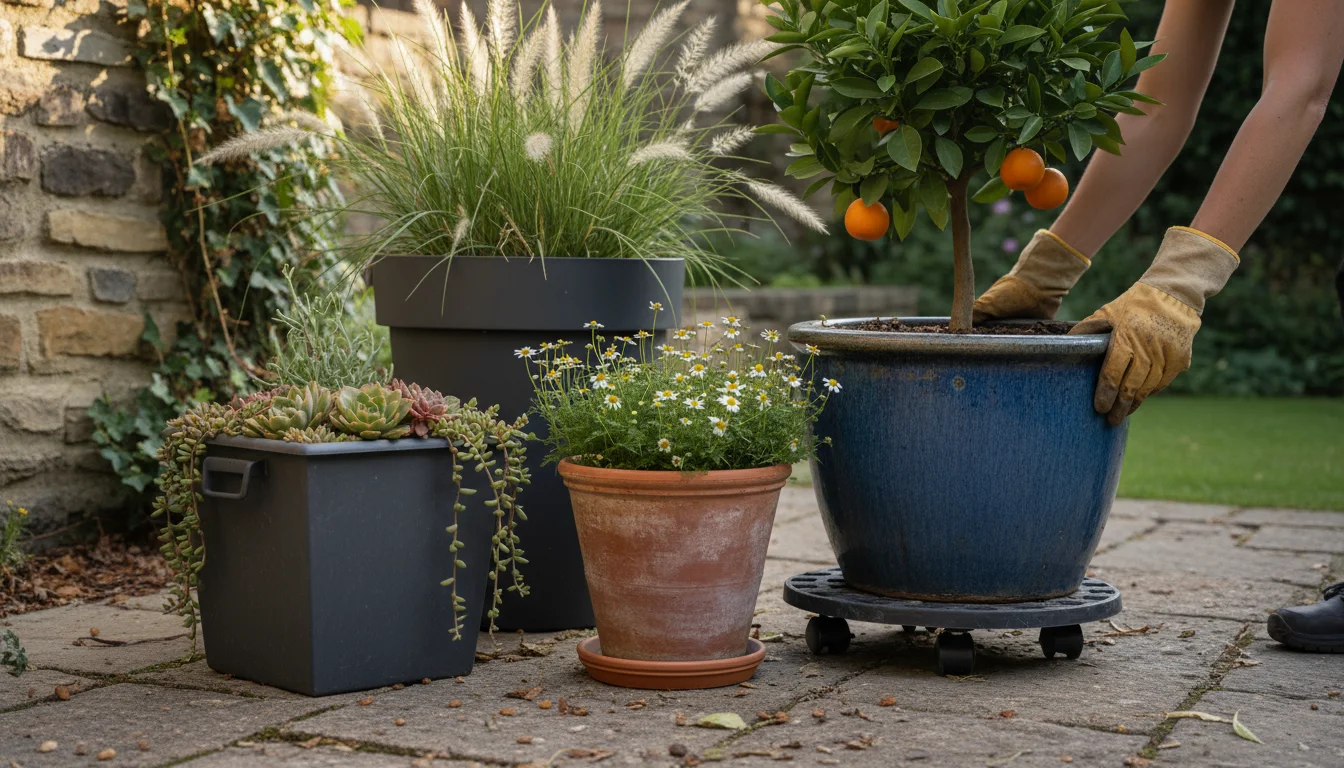
Mobility and Groupings
Consider placing heavier containers on wheeled caddies. This allows you to easily reposition plants to optimize light, protect them from extreme weather, or simply rearrange your design. Grouping containers creates a more substantial visual impact than scattering individual pots. Aim for groupings of three or more pots of varying sizes, heights, and textures. This creates a miniature landscape within your small space, enhancing your seasonal container gardening flexibility. When arranging, remember to leave adequate space for cleaning and watering. A general guideline for pathways suggests at least 24-30 inches of clear width for comfortable movement, even with container groupings nearby.
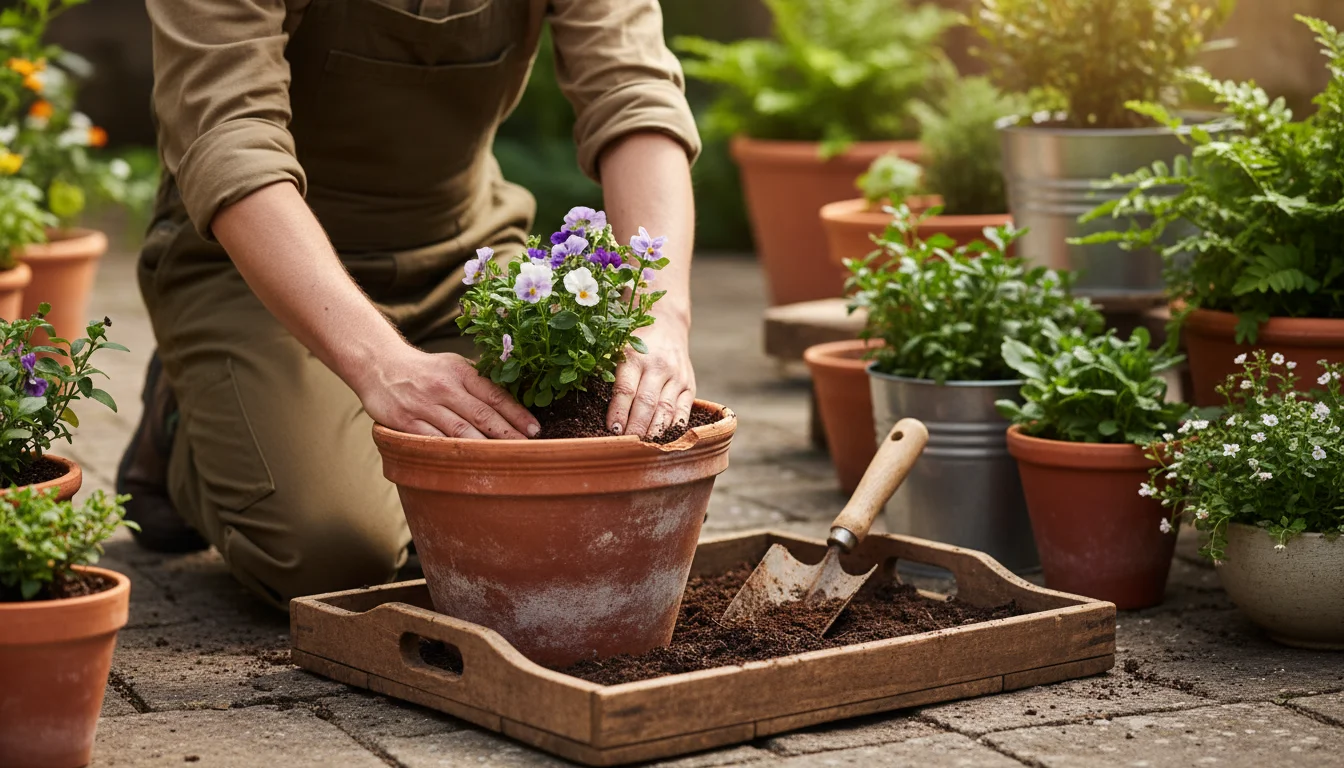
Sustainable Practices for Long-Term Success
Sustainability in seasonal container gardening means making environmentally conscious choices that benefit your plants, your wallet, and the planet. It focuses on reducing waste, conserving resources, and promoting biodiversity, all while creating beautiful year-round displays.
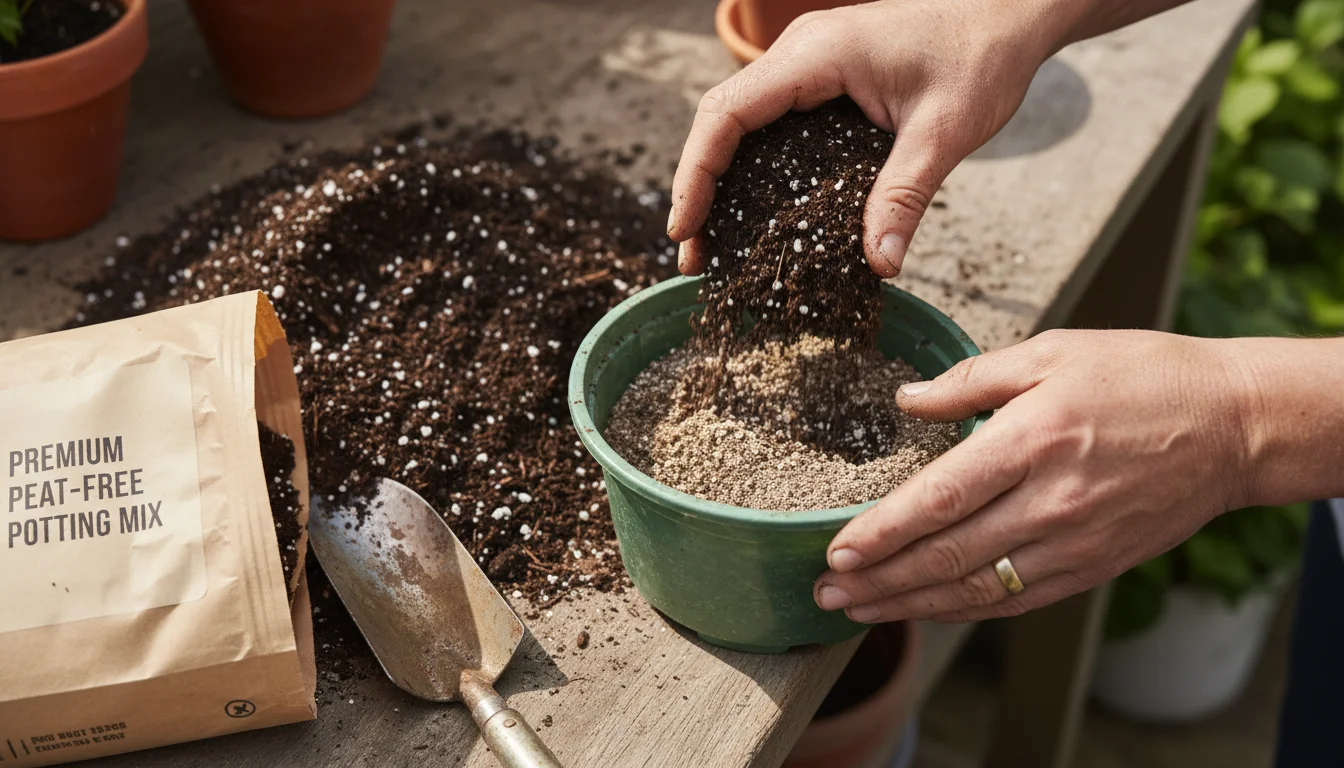
Choosing the Right Potting Mix
Your soil is the foundation of plant health. Use a high-quality, peat-free potting mix. Peat harvesting has significant environmental impacts, contributing to greenhouse gas emissions and wetland destruction. Many excellent alternatives exist, often containing coir, compost, and perlite, which offer superior drainage and aeration. Look for mixes labeled “organic” or “sustainable.”
To refresh old potting mix, do not just discard it. Remove spent plants, break up compacted soil, and amend it with fresh compost and a slow-release granular organic fertilizer. This rejuvenates the soil, providing nutrients for new seasonal plantings and reducing waste. A healthy soil microbiome is critical for nutrient uptake and plant resilience. Learn more about sustainable soil practices from organizations like the Rodale Institute, a leader in organic agriculture research.
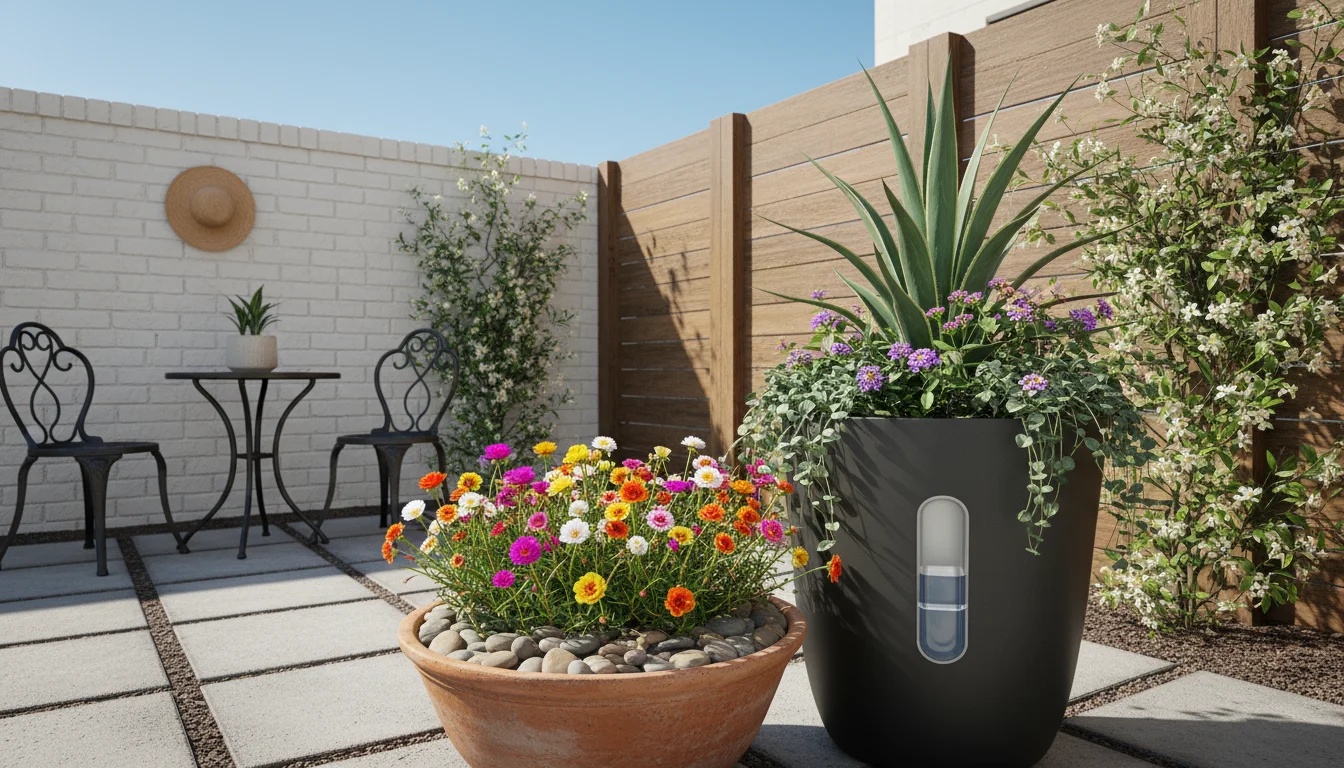
Water-Wise Choices and Techniques
Water conservation is paramount in container gardening. Containers dry out faster than garden beds, increasing water demand. Implement these strategies:
- Choose Drought-Tolerant Plants: Many beautiful plants thrive with less water. For summer, consider succulents, sedums, Portulaca, or ornamental grasses.
- Use Self-Watering Containers: These pots have a built-in reservoir that wicks water up to the soil, significantly reducing how often you need to water.
- Mulch Your Containers: A layer of shredded bark, gravel, or even decorative stones on top of the soil reduces evaporation, keeps roots cooler, and suppresses weeds.
- Water Deeply, Less Frequently: When you do water, soak the container thoroughly until water drains from the bottom. This encourages deeper root growth. Allowing the top inch or two of soil to dry out between waterings prevents root rot and conserves water.
- Collect Rainwater: A small rain barrel provides a sustainable source of soft, chemical-free water for your plants.
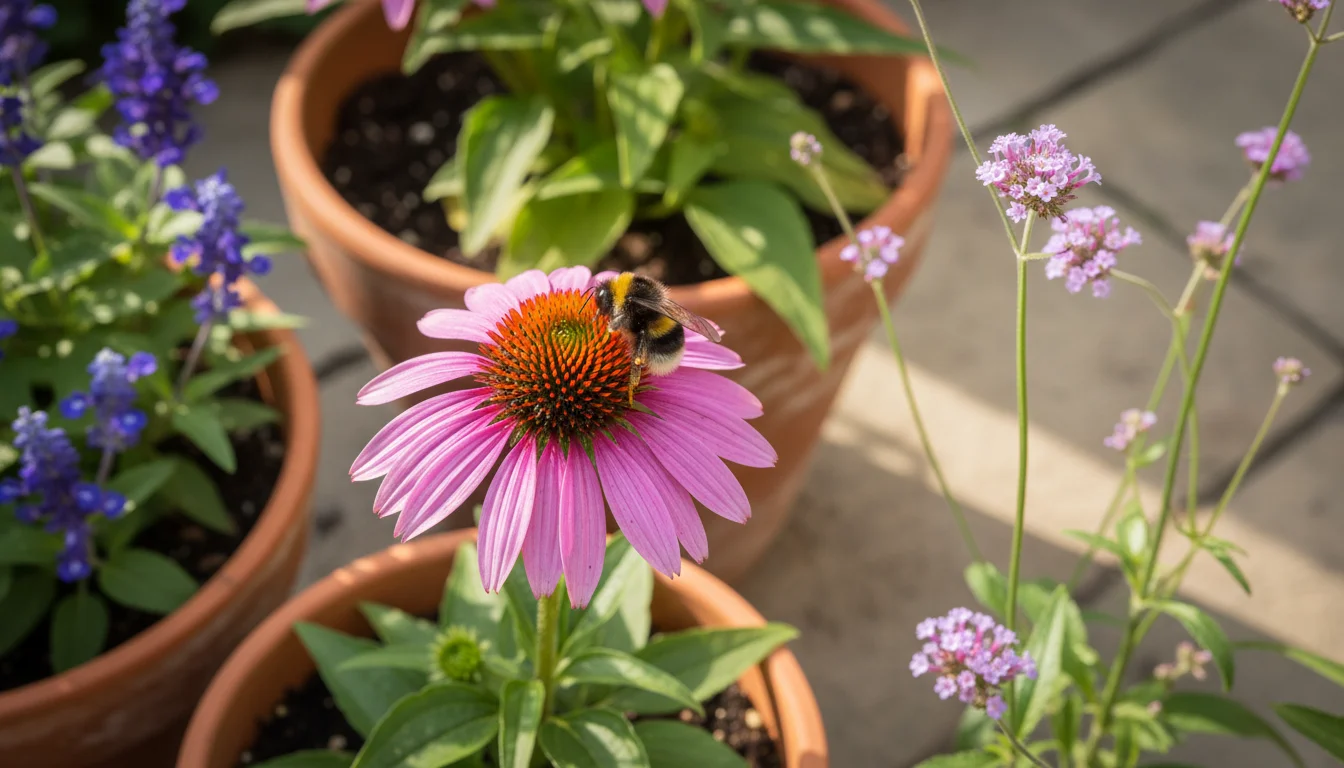
Embracing Native and Pollinator-Friendly Plants
Integrate native plants into your seasonal container gardening. Native species are naturally adapted to your local climate and soil conditions, requiring less water, fertilizer, and pest control. They also provide essential food and habitat for local pollinators, such as bees, butterflies, and hummingbirds. Even in containers, a few pollinator-friendly plants make a difference. Good choices include coneflowers, salvia, verbena bonariensis, and various herbs like basil and mint, all of which offer excellent garden color ideas. By supporting local ecosystems, you contribute to broader environmental health. For local native plant recommendations, consult your regional extension service, such as the Oregon State University Extension Service.
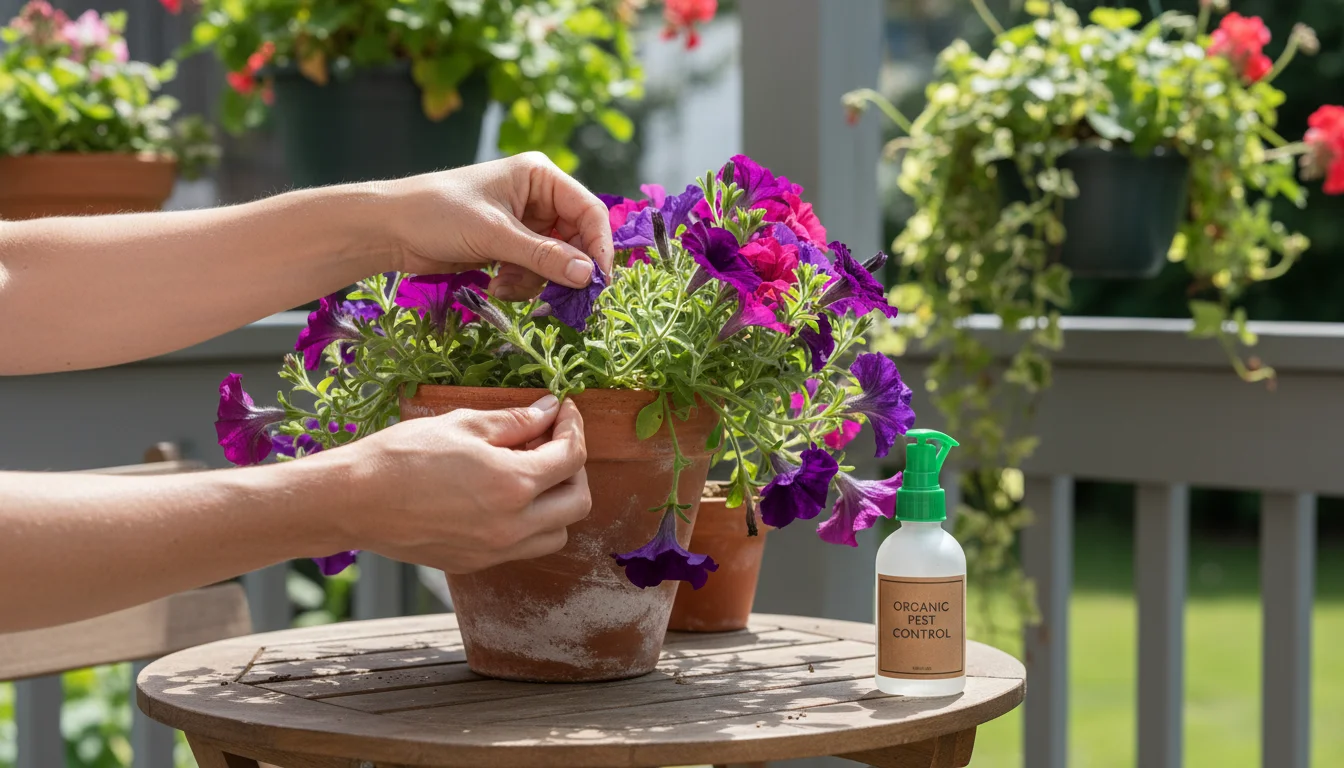
Long-Term Plant Care and Pest Management
Regular maintenance keeps your year-round displays thriving. Deadhead spent flowers, pinch back leggy growth to encourage bushiness, and prune as needed. Inspect your plants regularly for signs of pests or diseases. Address issues early with organic solutions like insecticidal soap or neem oil. Avoid broad-spectrum chemical pesticides, which harm beneficial insects. Consider composting spent plant material and old potting mix, returning valuable nutrients to your garden cycle. By thinking long-term, you create a garden that is beautiful and also resilient and environmentally responsible.
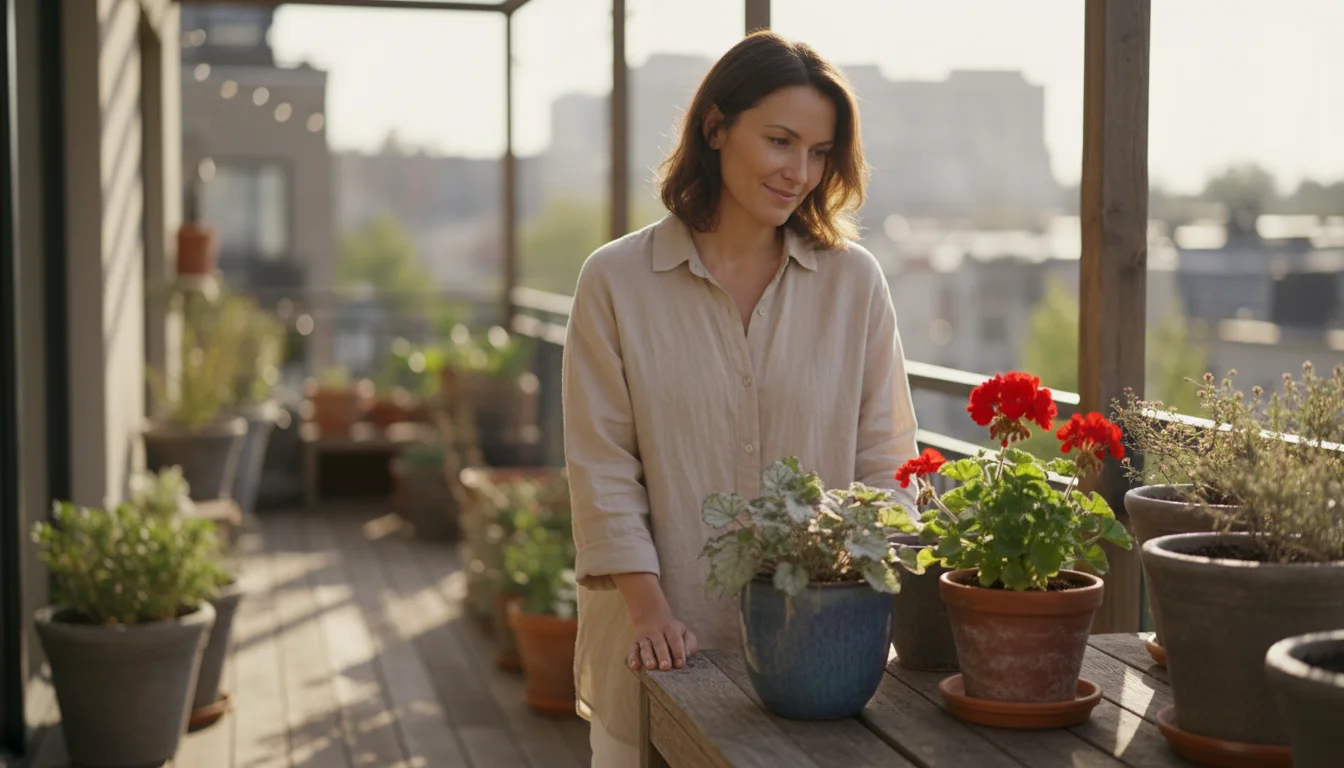
Frequently Asked Questions
What are the best plants for year-round displays in containers?
The best plants depend on your climate zone and local conditions. However, a good strategy involves using a mix of hardy evergreens for structure (dwarf conifers, boxwood, holly), rotating seasonal annuals for color (pansies, petunias, mums), and incorporating tough perennials that can overwinter in containers (heuchera, sedum, some ornamental grasses). Always check plant tags for hardiness zones and sun requirements.
How often should I change my seasonal container plantings?
Generally, you change your primary flowering plants with each new season, approximately four times a year. Spring plantings often go in around March or April, summer plants in May or June, fall plants in September, and winter-hardy arrangements in November. However, many evergreens or long-blooming perennials can remain in place for multiple seasons or even years, forming the backbone of your year-round displays.
Can I grow edibles in seasonal container displays?
Absolutely! Many edibles thrive in containers and look beautiful. You can integrate herbs like rosemary, thyme, and basil, leafy greens such as lettuce and spinach, or even dwarf fruit trees and berry bushes. Choose varieties suited for container growth and ensure they receive adequate sunlight and nutrients. Edibles add a practical, delicious dimension to your garden color ideas.
What kind of soil mix works best for containers?
Use a high-quality, peat-free potting mix specifically formulated for containers. This provides good drainage, aeration, and nutrient retention. Avoid using garden soil, which compacts too easily in pots and can introduce pests or diseases. Amend old potting mix with fresh compost and a slow-release organic fertilizer to revitalize it for new seasonal plantings.
For design and plant selection guidance, visit
Missouri Botanical Garden,
Kew Science, Plants of the World,
University of Minnesota Extension, and
National Garden Association.
Disclaimer: This article is for informational purposes only and is not a substitute for professional advice. Consult local extension services for region-specific recommendations.
